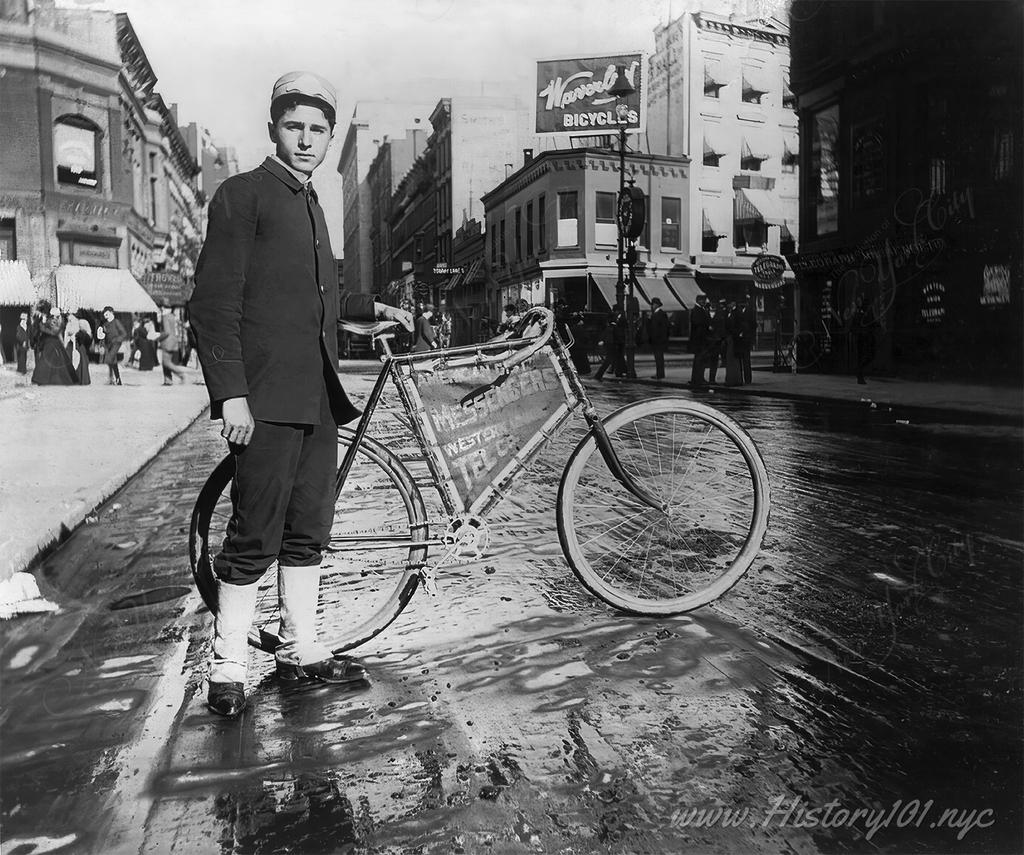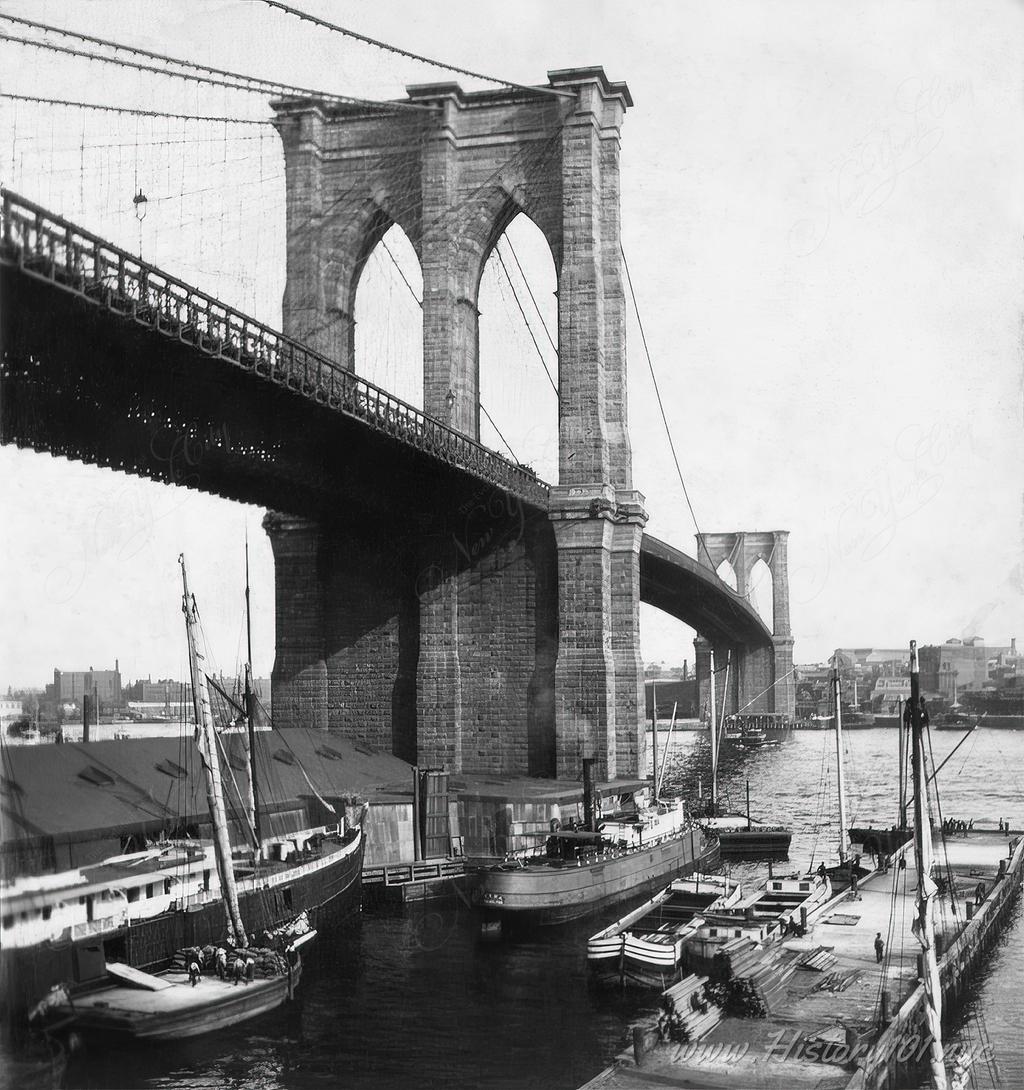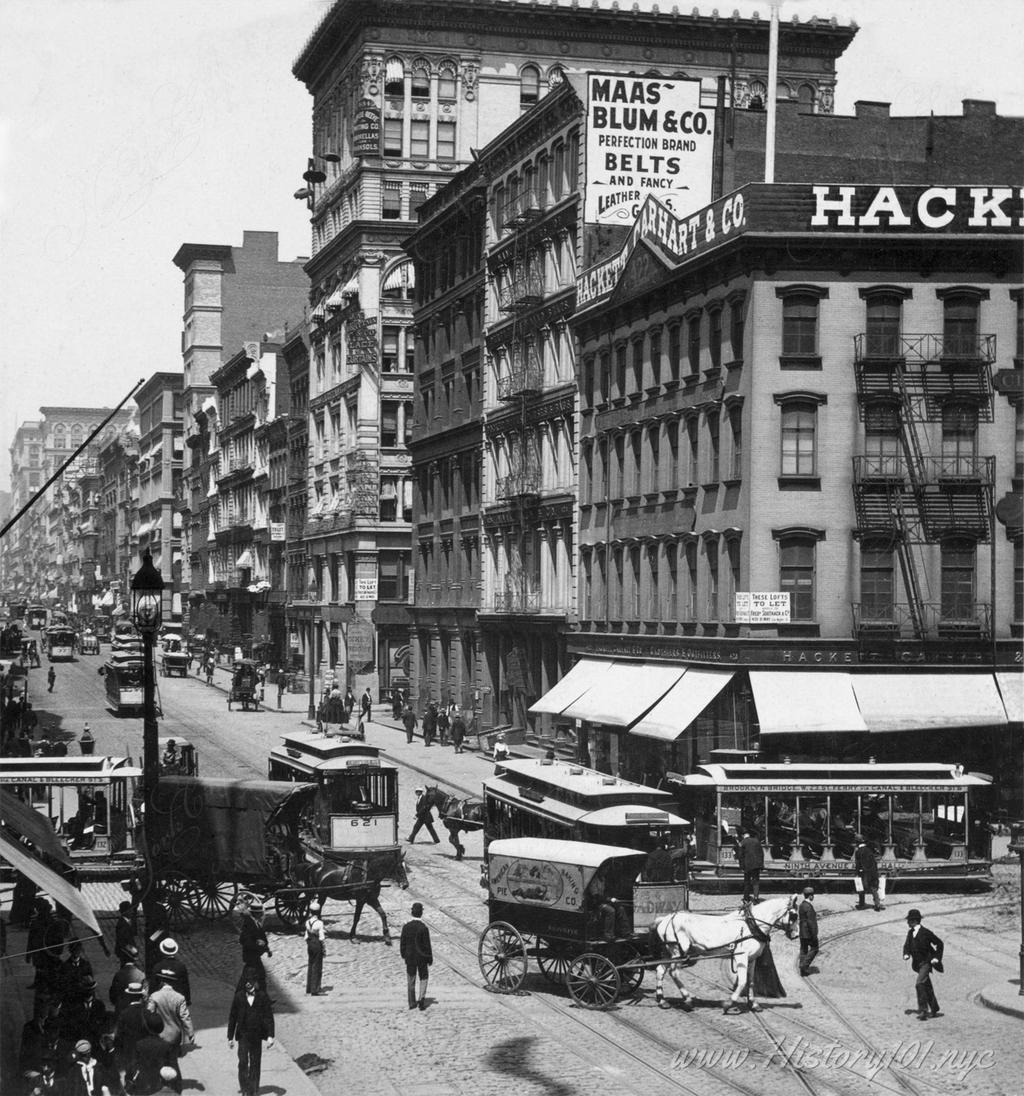
1890s NYC: The Gilded Age Transformation, Architectural & Cultural Emergence
The 1890s in New York City marked a period of extraordinary transformation, both in its urban landscape and its global influence. As a key part of the Gilded Age, this decade saw New York City make significant strides in urban development, culture, and industry. The construction of monumental structures began during this era, including the iconic Flatiron Building, which started in 1899, symbolizing New York’s architectural and industrial ambitions.
During this time, New York City’s transportation infrastructure was enhanced by the expansion of elevated railways, such as the completion of the Third Avenue Elevated Line in 1896, which played a crucial role in connecting neighborhoods and supporting the city’s rapid growth. Cultural institutions, like the New York Public Library, saw significant developments, with construction on the main branch starting in 1897, reflecting the city’s commitment to intellectual and cultural enrichment.
The 1890s were characterized by stark social and economic contrasts. While the era was dominated by the wealth and power of families like the Rockefellers and Vanderbilts, the working class faced significant challenges, laying the groundwork for major labor movements. This juxtaposition of opulence and struggle defined New York City’s character during this transformative decade.
This era in New York City’s history is a testament to its enduring spirit and capacity for growth. As a reflection of American progress and challenges, New York City during the Gilded Age offers a fascinating glimpse into the evolution of one of the world’s most iconic cities.
Timeline of New York City’s History in the 1890s
Discover surprising historical facts about The City That Never Sleeps—explore fun, educational insights into its history, population, iconic landmarks, and more, perfect for students, history enthusiasts, and anyone curious about NYC’s rich heritage.
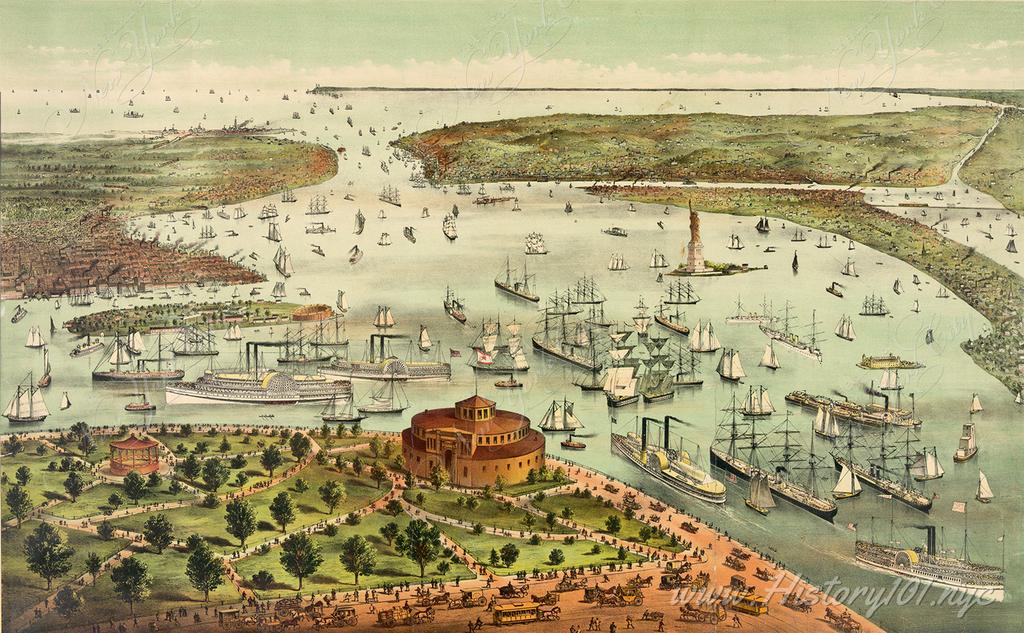
1890: Aerial View of The Battery
The Port of New York - a bird's eye view from the Battery, looking south.
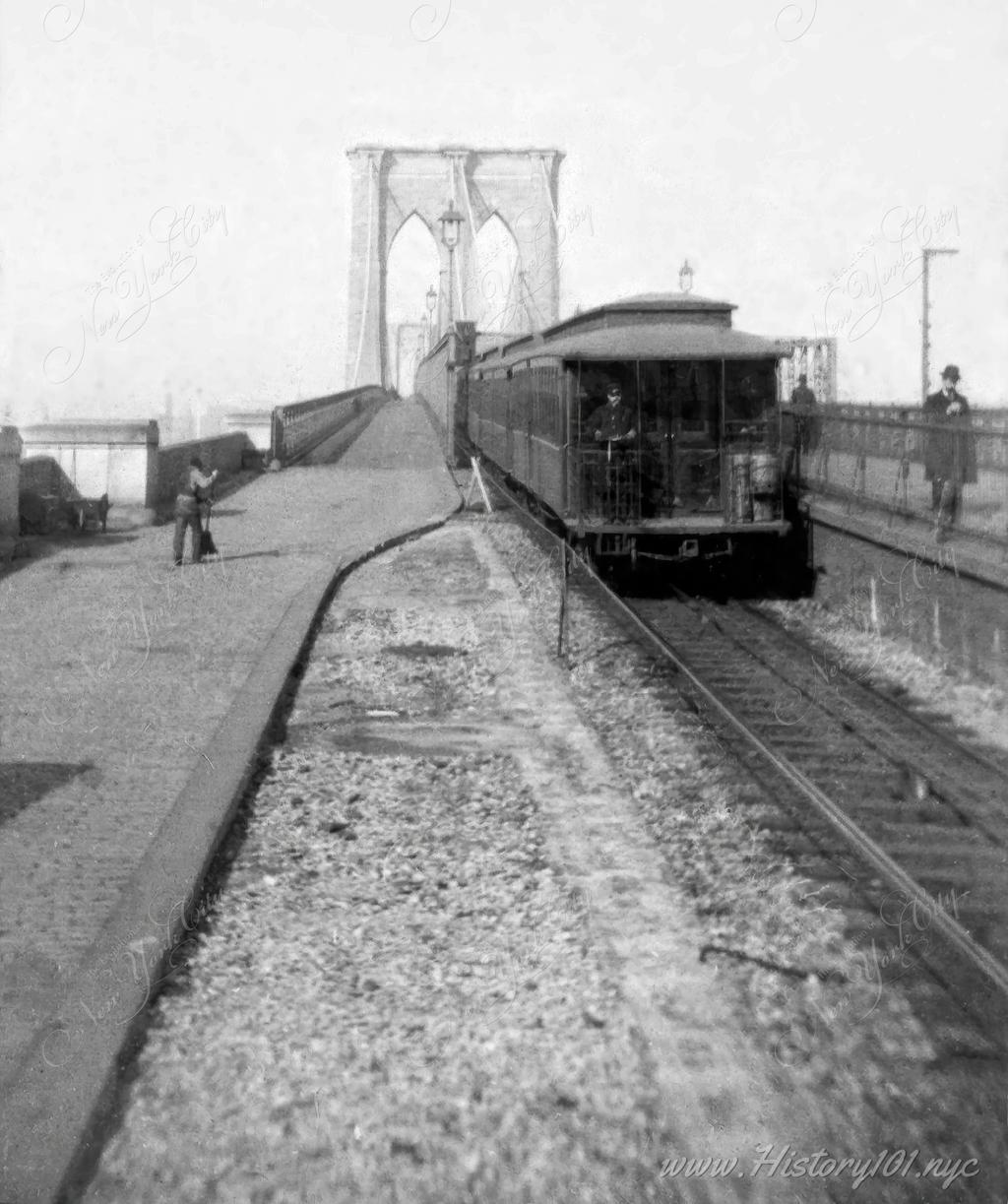
1898: Brooklyn Bridge Trolley
Photograph of a the trolley tracks on the Brooklyn Bridge. A city worker is seen cleaning the platform on the left while commuters are seen walking on the right.
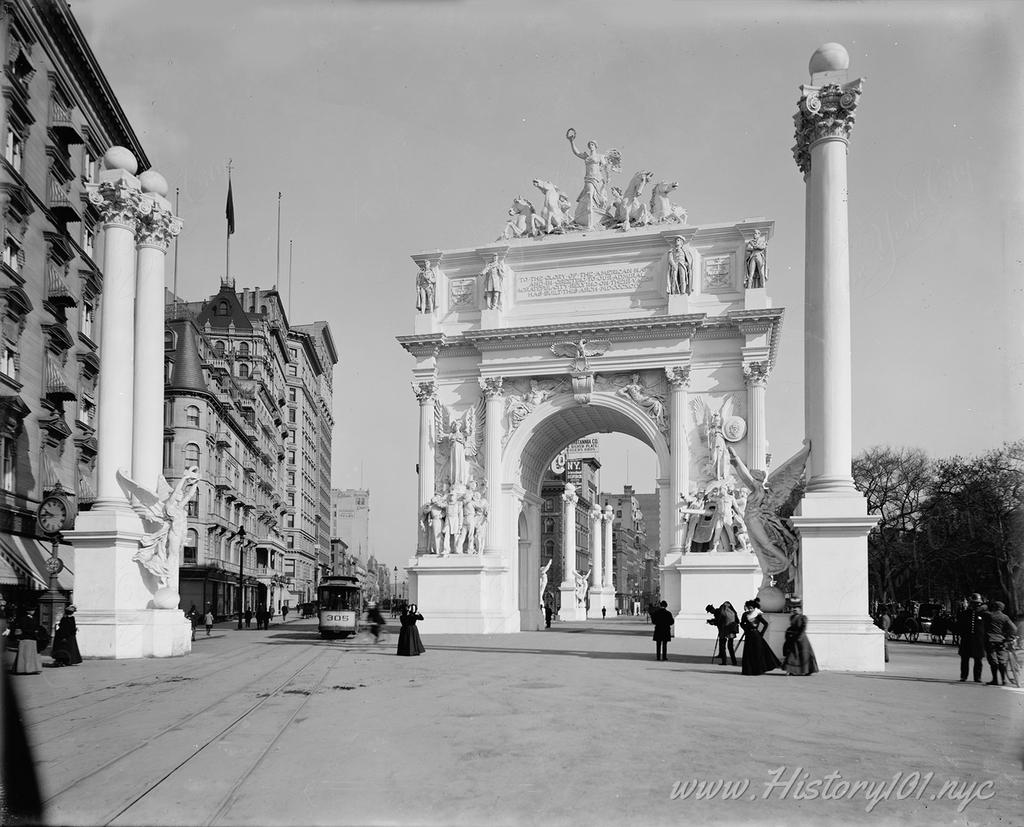
1898: Dewey Arch
The Dewey Arch was a triumphal arch that stood from 1899 to 1900 at Madison Square in Manhattan. It was erected for a parade in honor of Admiral George Dewey.
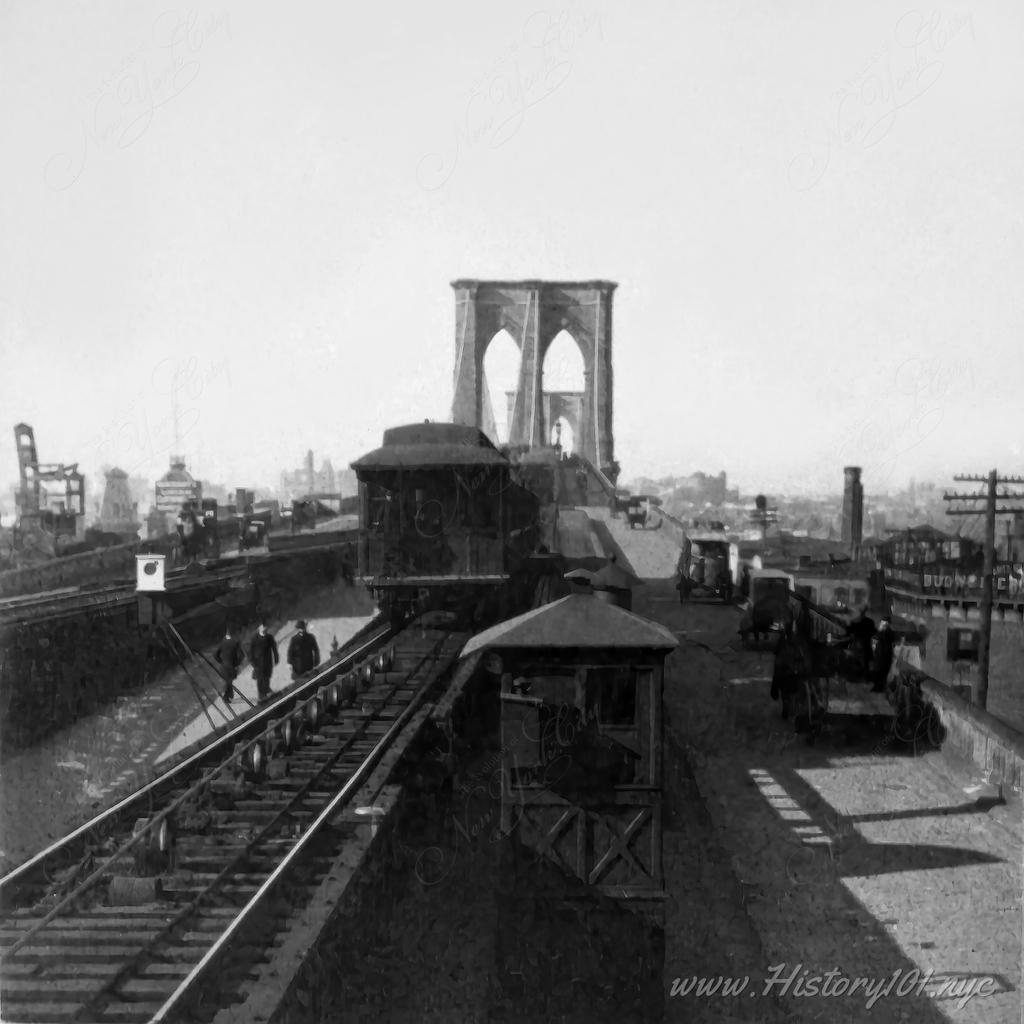
1898: Brooklyn Bridge Trolley Station
Various Companies Operated Local Trolley Lines over the Brooklyn Bridge.
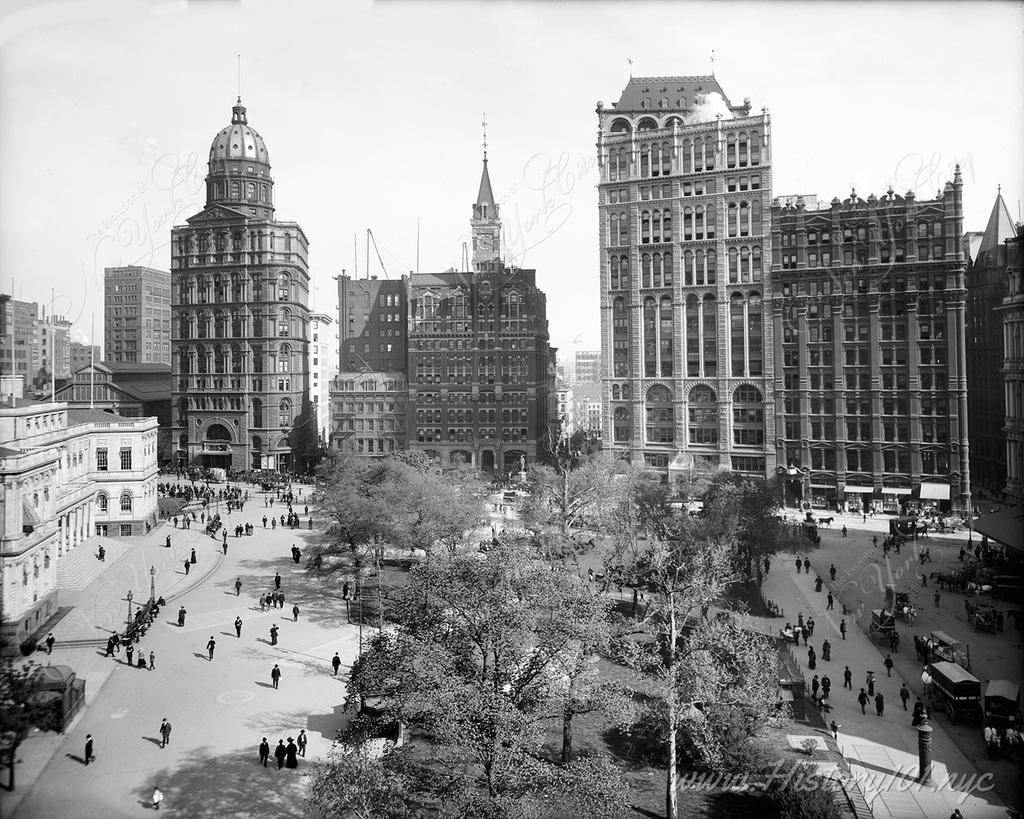
1890: Newspaper Row
An aerial photograph of Park Row, also known as Newspaper Row as it became the epicenter of 19th century news.
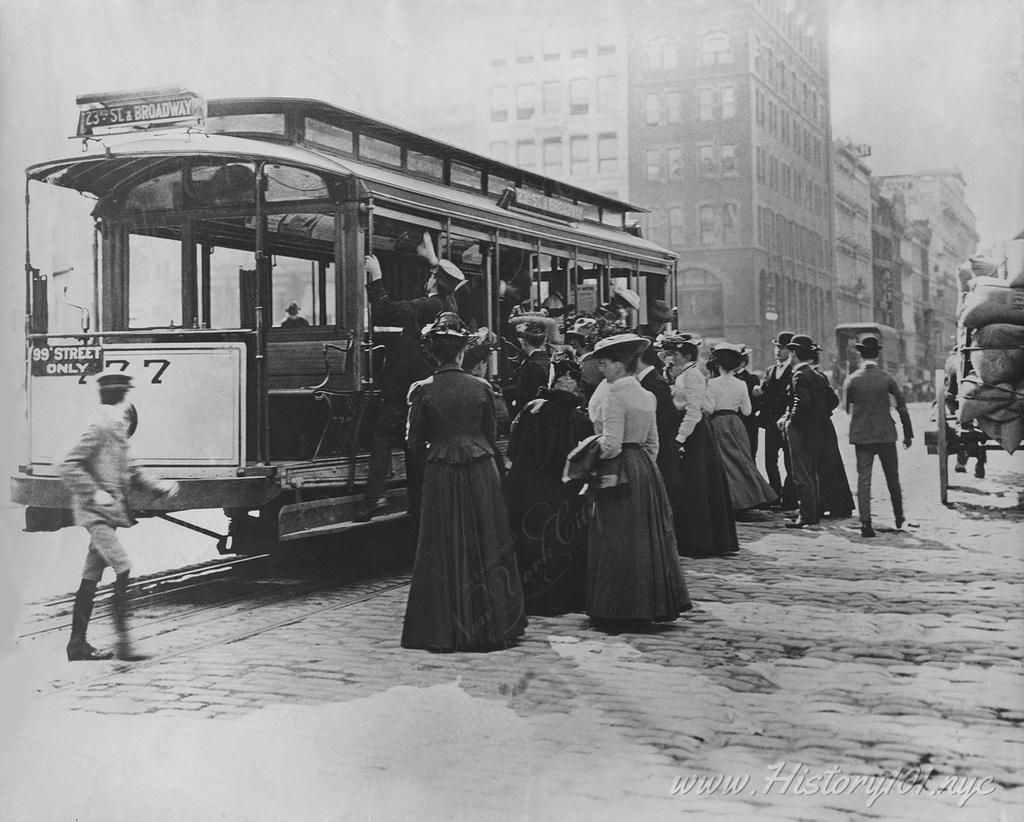
1890: New York Streetcar
Photograph of commuters waiting to board a New York City streetcar, headed towards 23rd Street and Broadway.
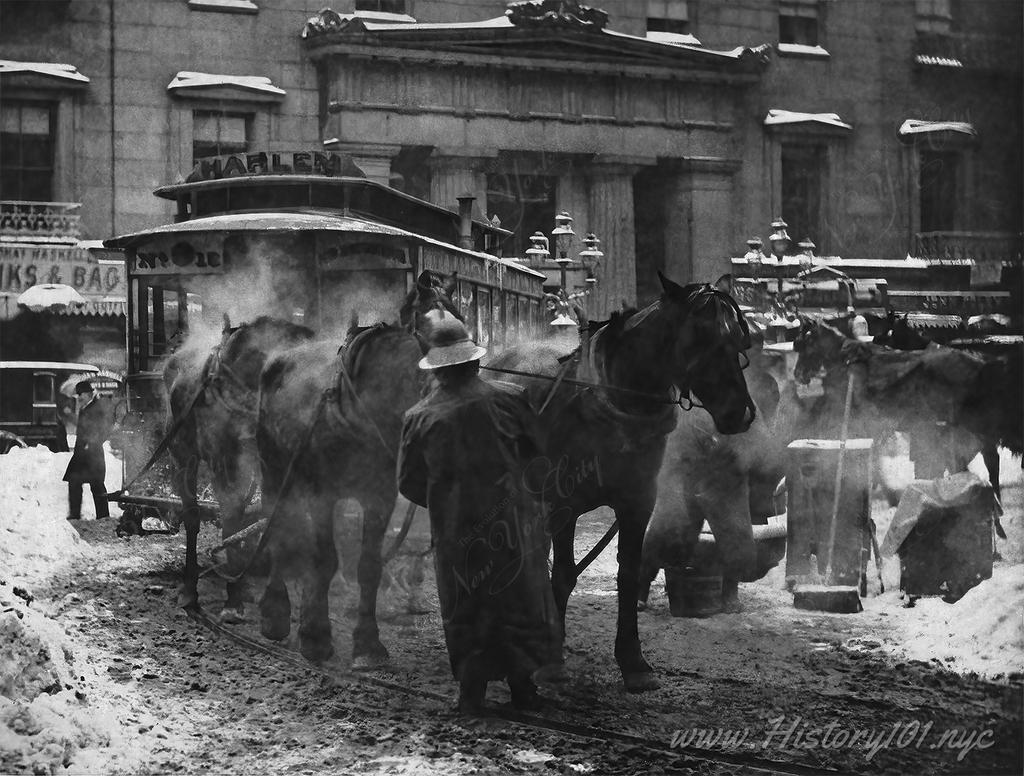
1893: Horse Trolley at Astor House Hotel
Photograph of a horse drawn trolley in front of the Astor House Hotel.
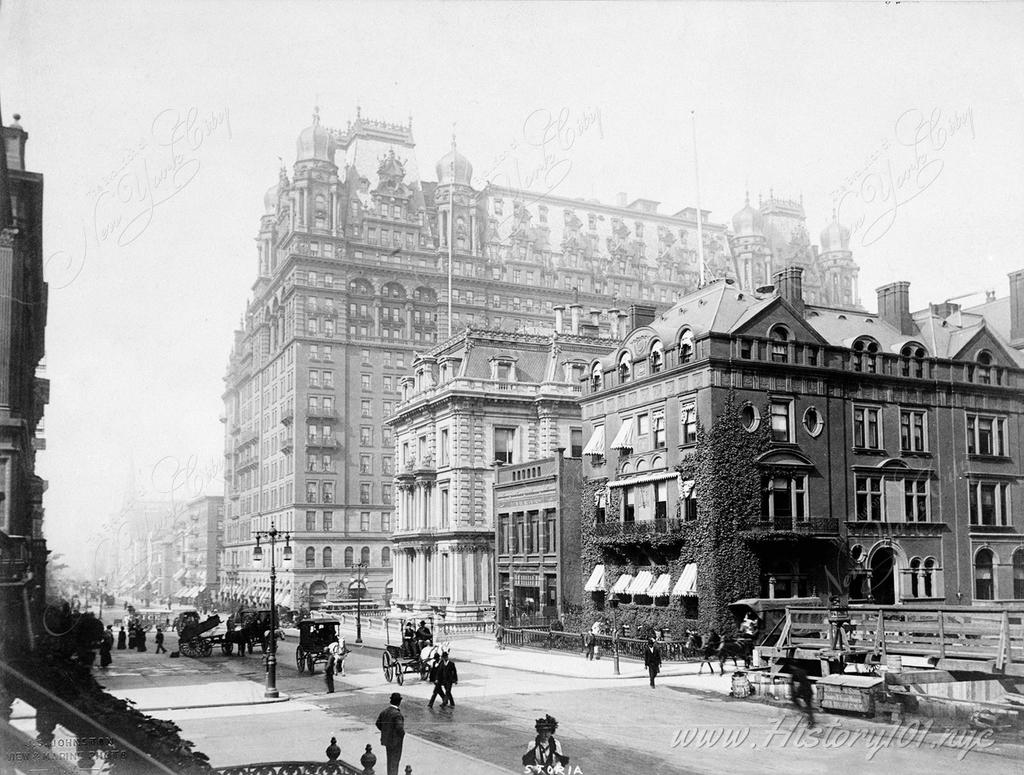
1899: The Waldorf Astoria
Photograph of the Waldorf-Astoria built in 1893 on 5th Avenue, south from 35th Street.
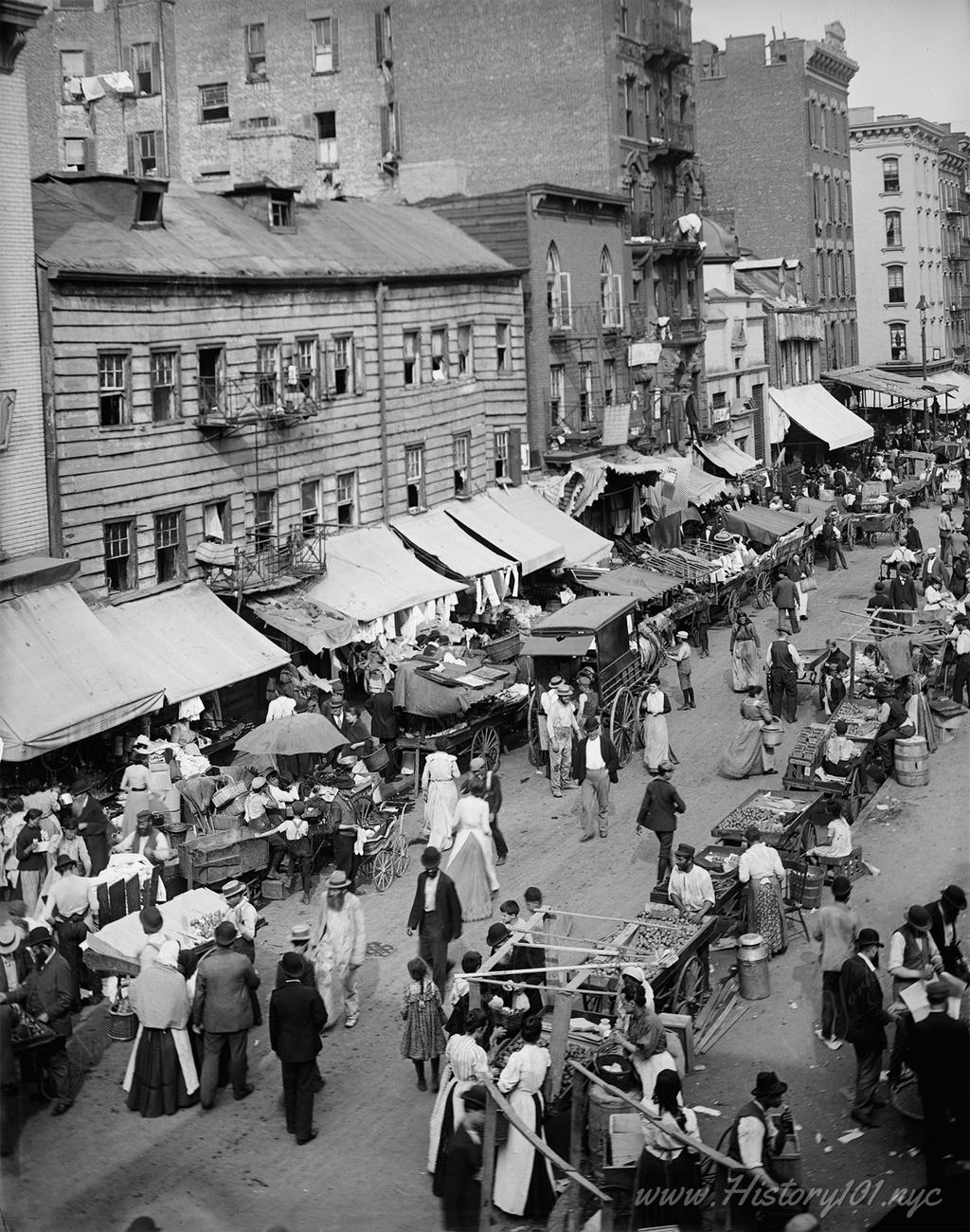
1899: Jewish Market on the East Side
Photograph of a busy East side street lined with Jewish markets and filled with pedestrians.
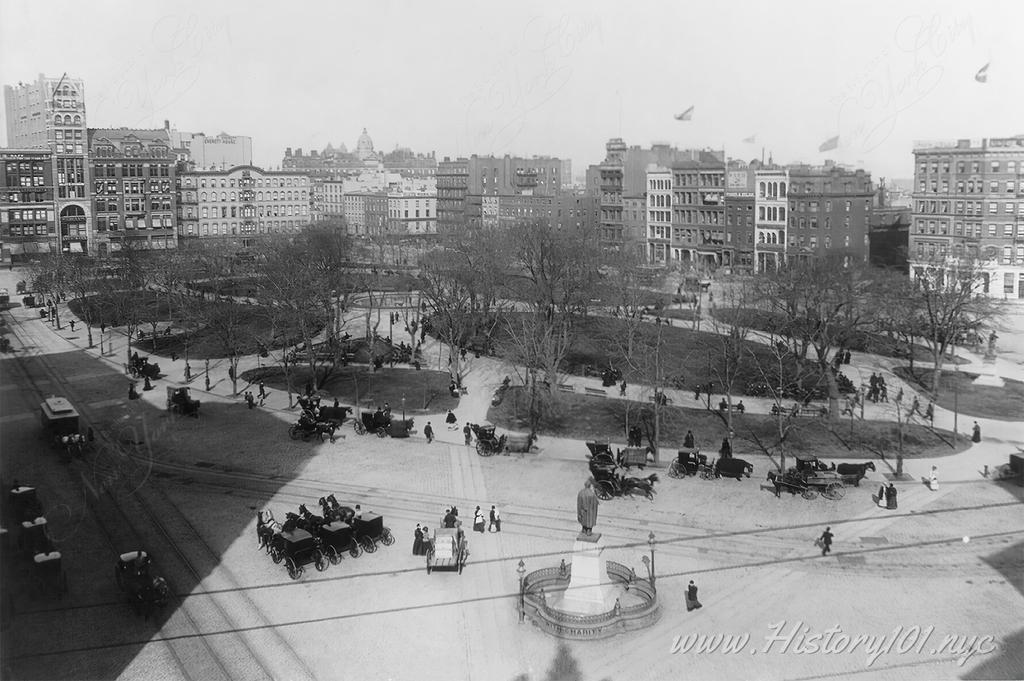
1893: Union Square, Looking NorthEast
Aerial photograph above Union Square filled with people and horses and the Lincoln Statue in the foreground.
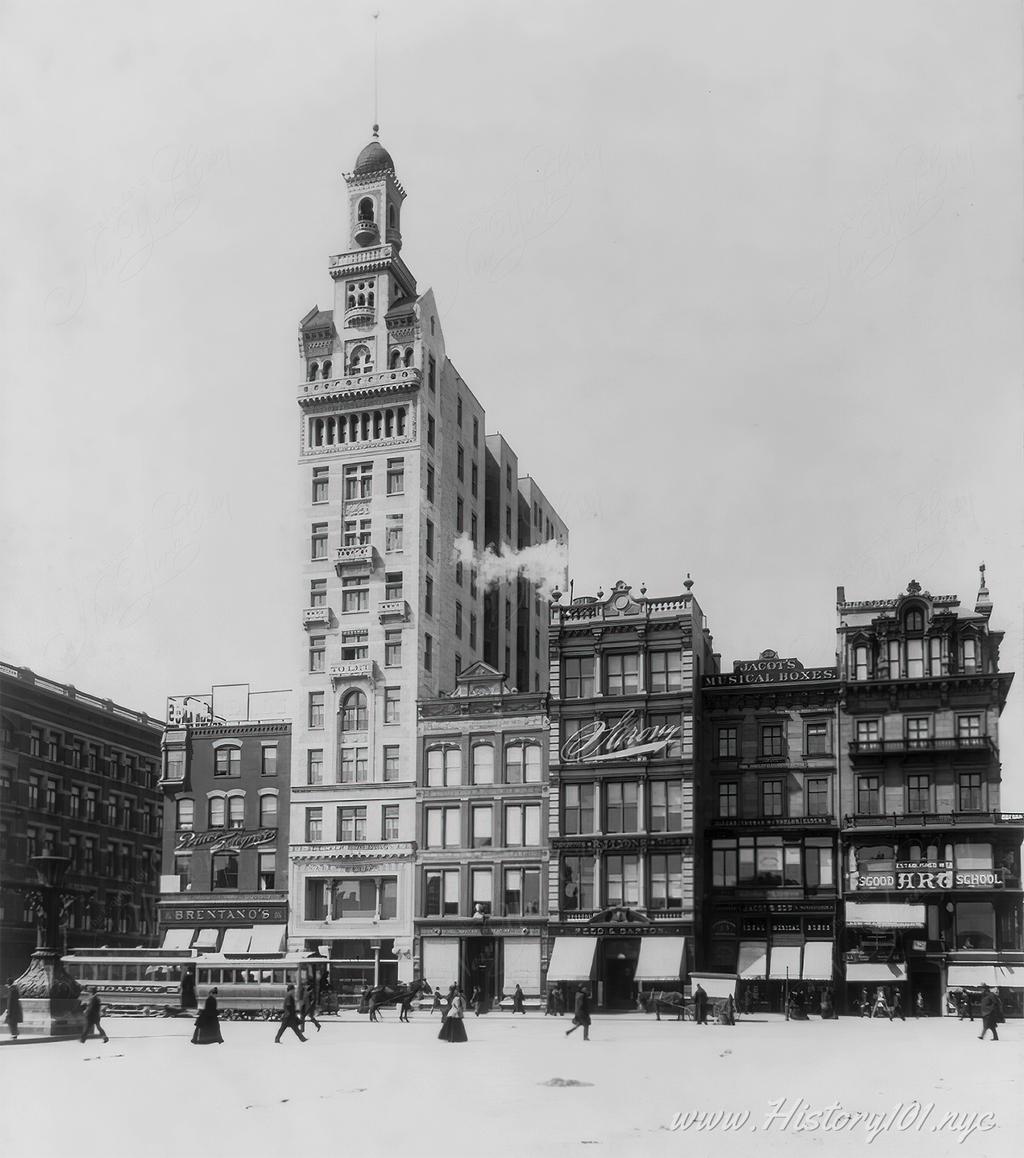
1894: The Decker Building, Union Square
Photograph of the Decker Building overlooking Union Square. The structure was completed in 1892 for the Decker Brothers piano company, and designed by John H. Edelmann.
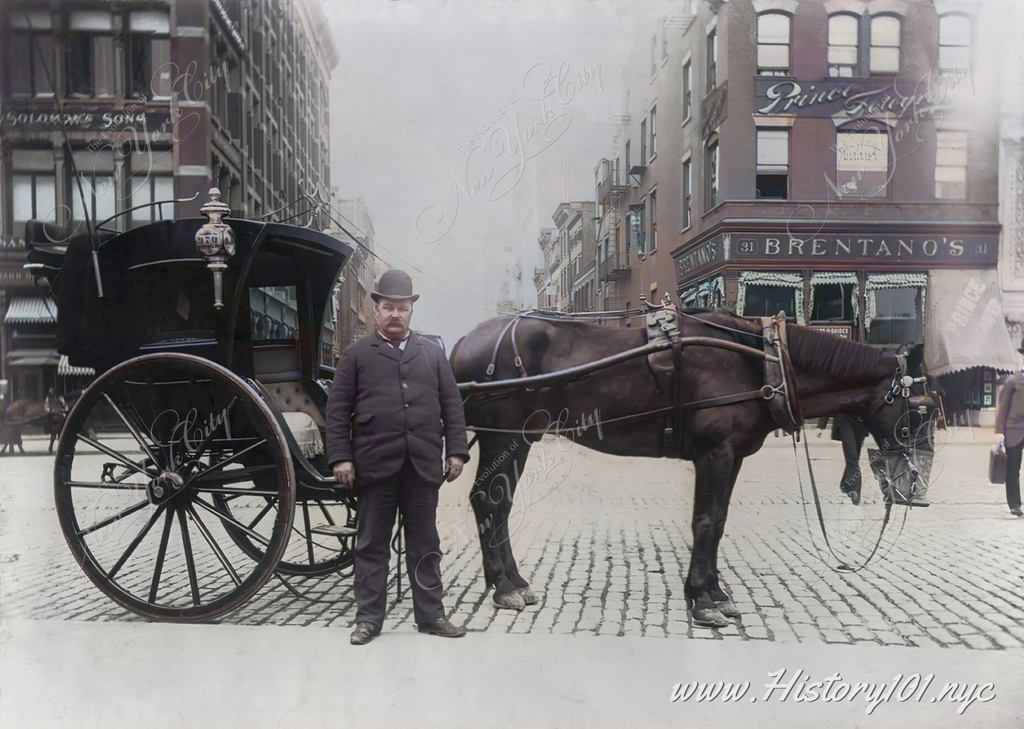
1896: NYC Hansom Cab Driver: Union Square & The Dawn of Urban Transit Evolution
Discover the 1896 photograph capturing NYC's hansom cab driver, a testament to urban transportation's evolution and the city's enduring spirit
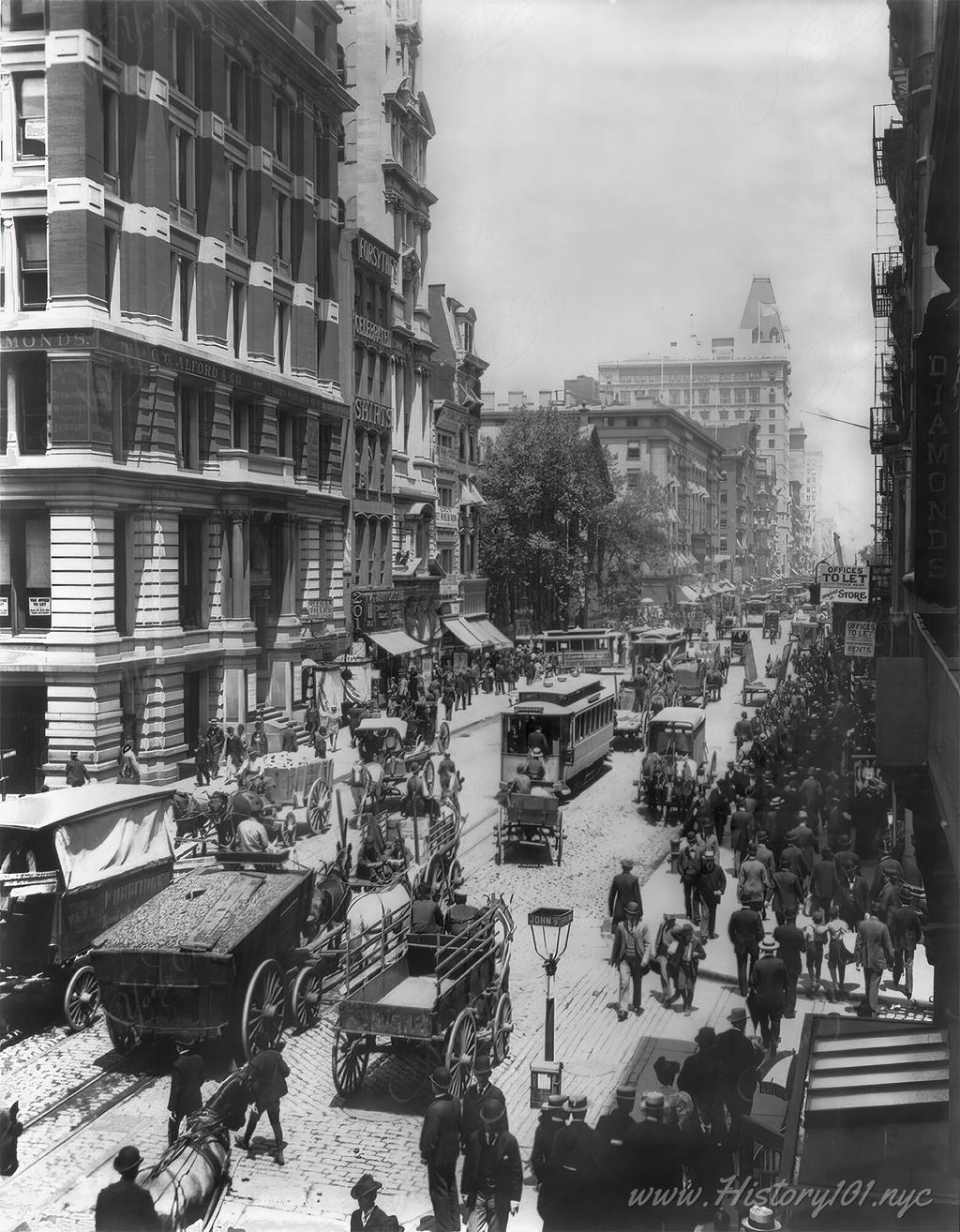
1895: Broadway and John Street
Photograph of Broadway near John Street filled with carriages and pedestrians.
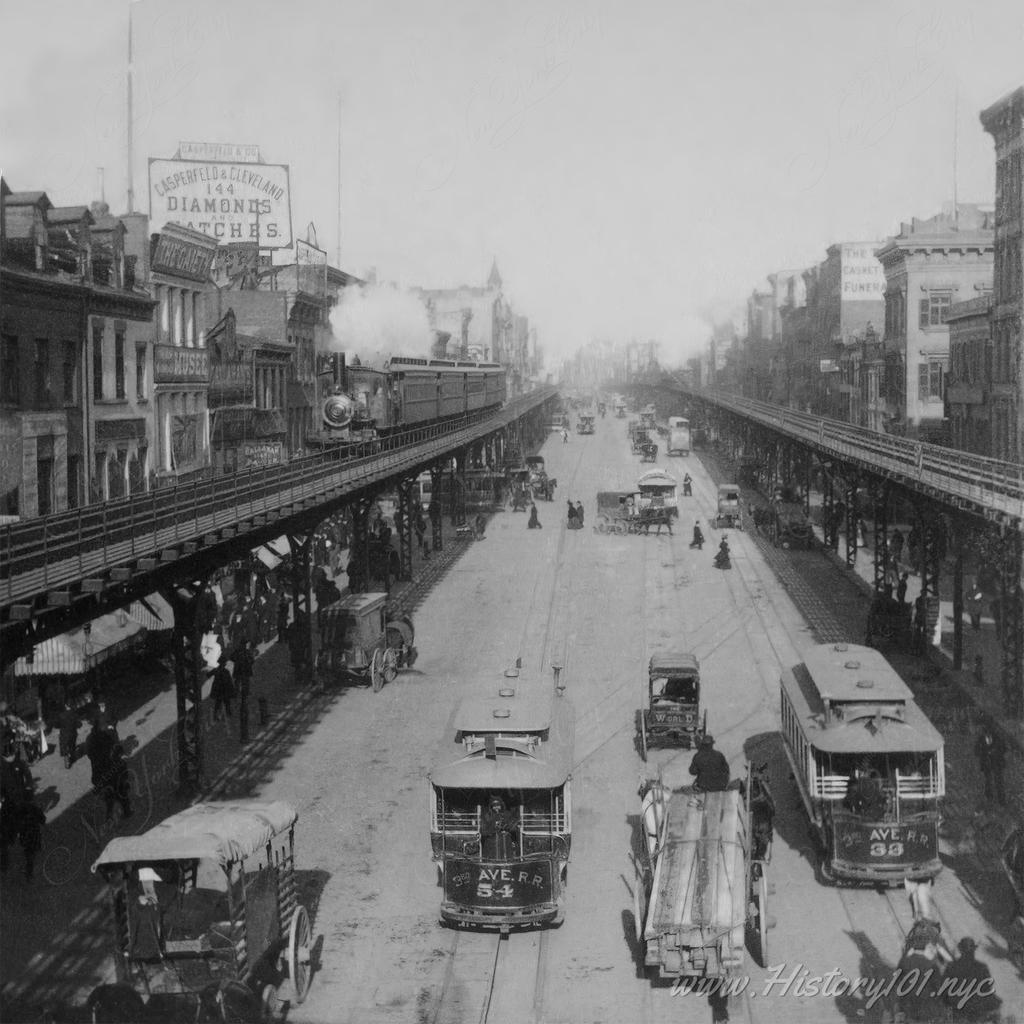
1896: Along the Bowery
Photograph showing elevated railroad, delivery wagons, streetcars, buildings and people in lower Manhattan.
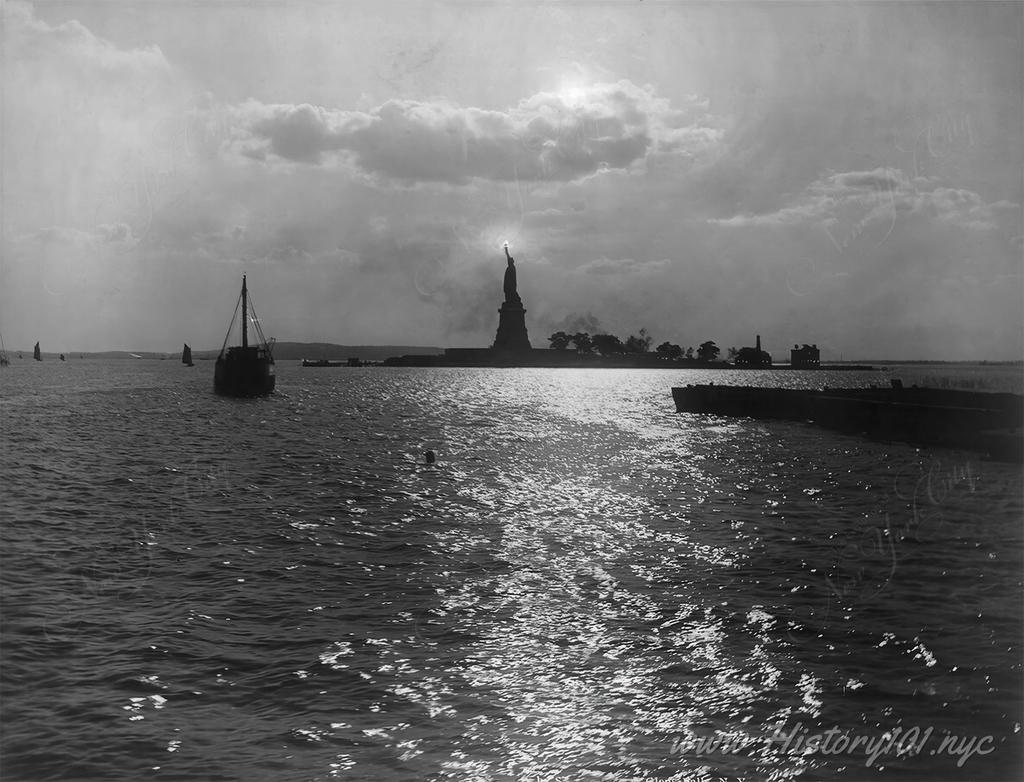
1890: Statue of Liberty
Photograph of the Statue of Liberty with her torch illuminating the sky over New York Harbor.
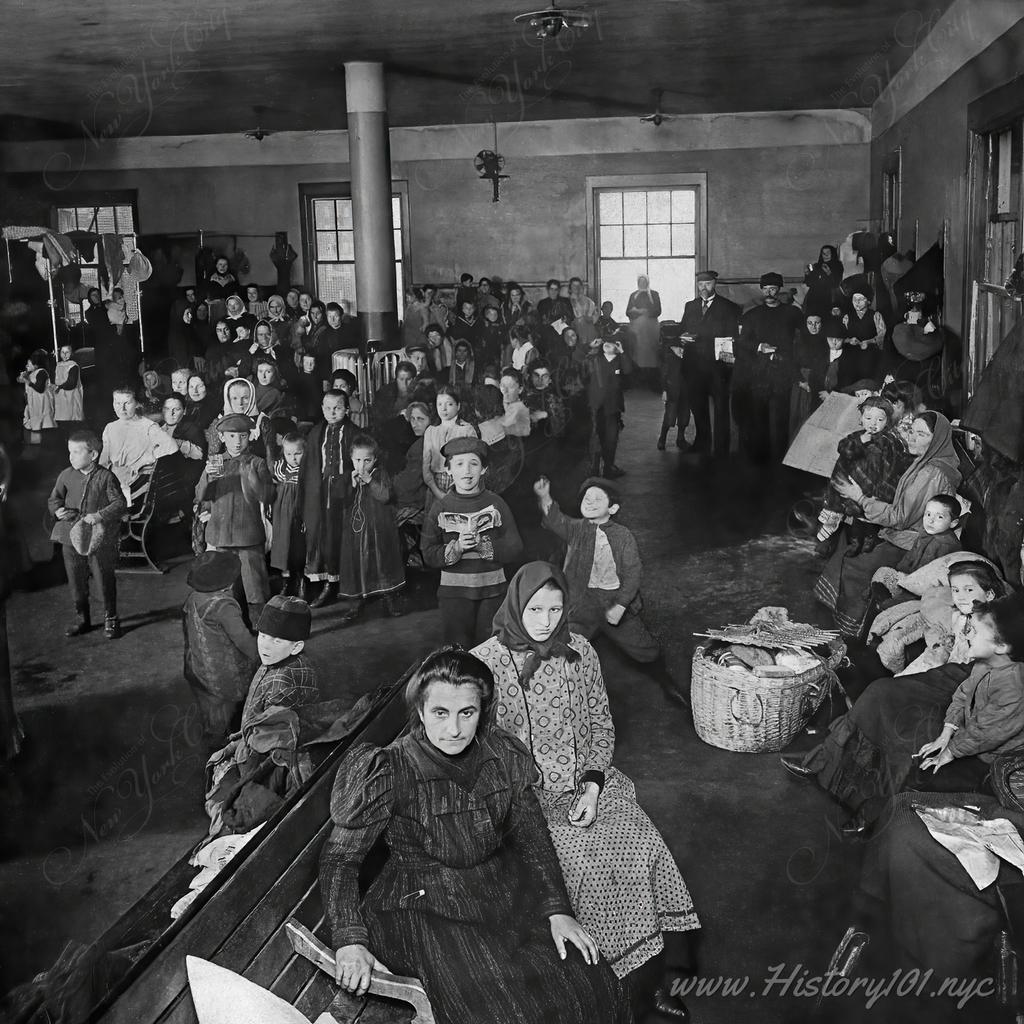
1892: Ellis Island (1892-1954): Immigrants Just Arriving, Awaiting examination
Explore Ellis Island's pivotal role from 1892-1954 in shaping NYC's culture and America's immigrant history
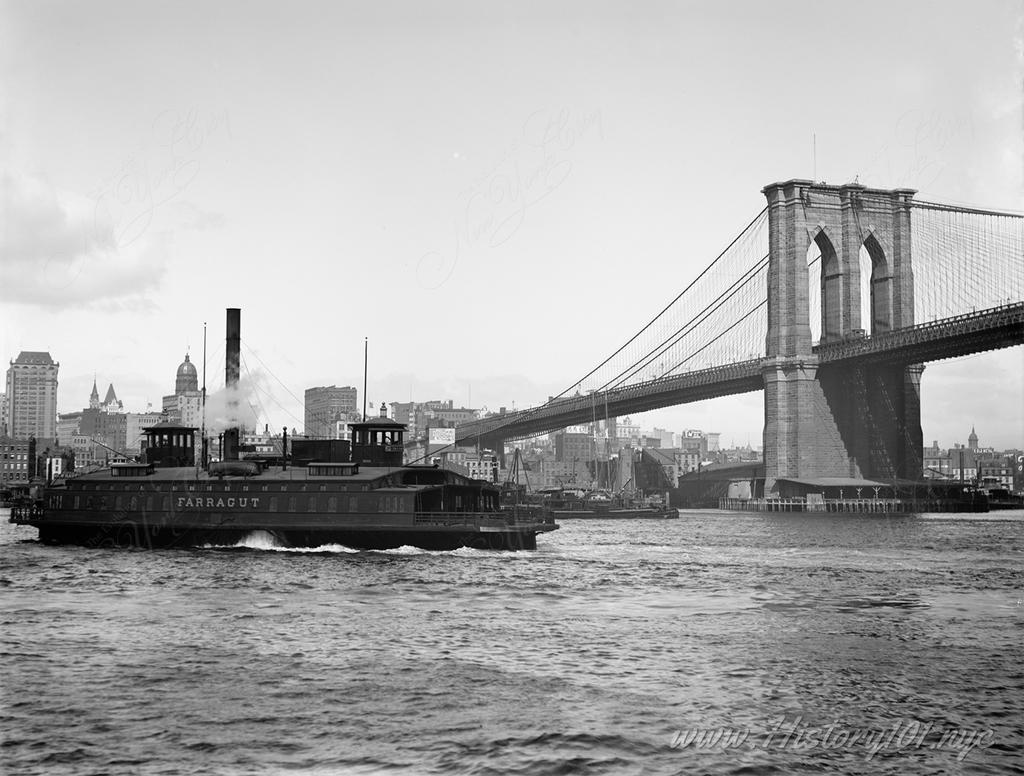
1895: Fulton Ferry Brooklyn Bridge
Photograph of the Fulton Ferry crossing the East River with the Brooklyn Bridge in the background.
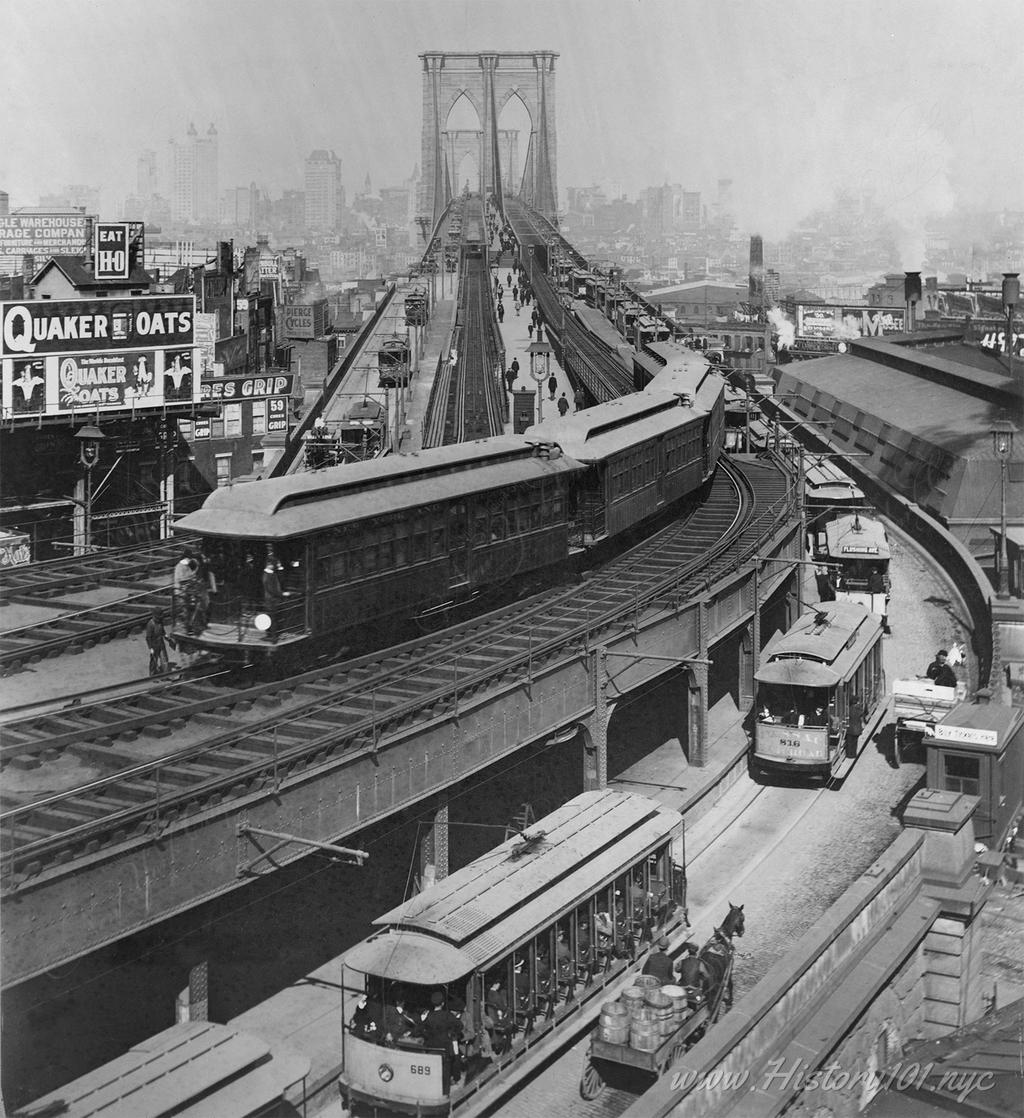
1898: Brooklyn Bridge Terminal
Photograph of the curved overpass at Brooklyn Terminal, New York & Brooklyn Bridge.
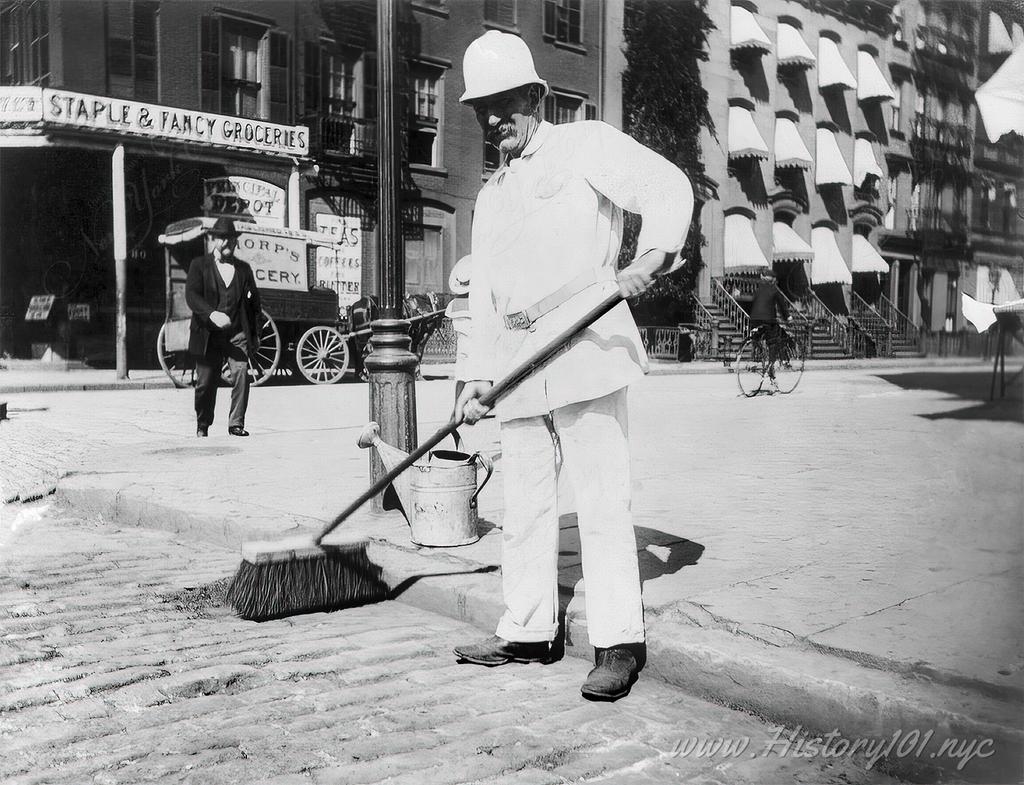
1896: Street Sweeper and Broom
Photograph of a city worker sweeping the street in front of a corner grocery store.
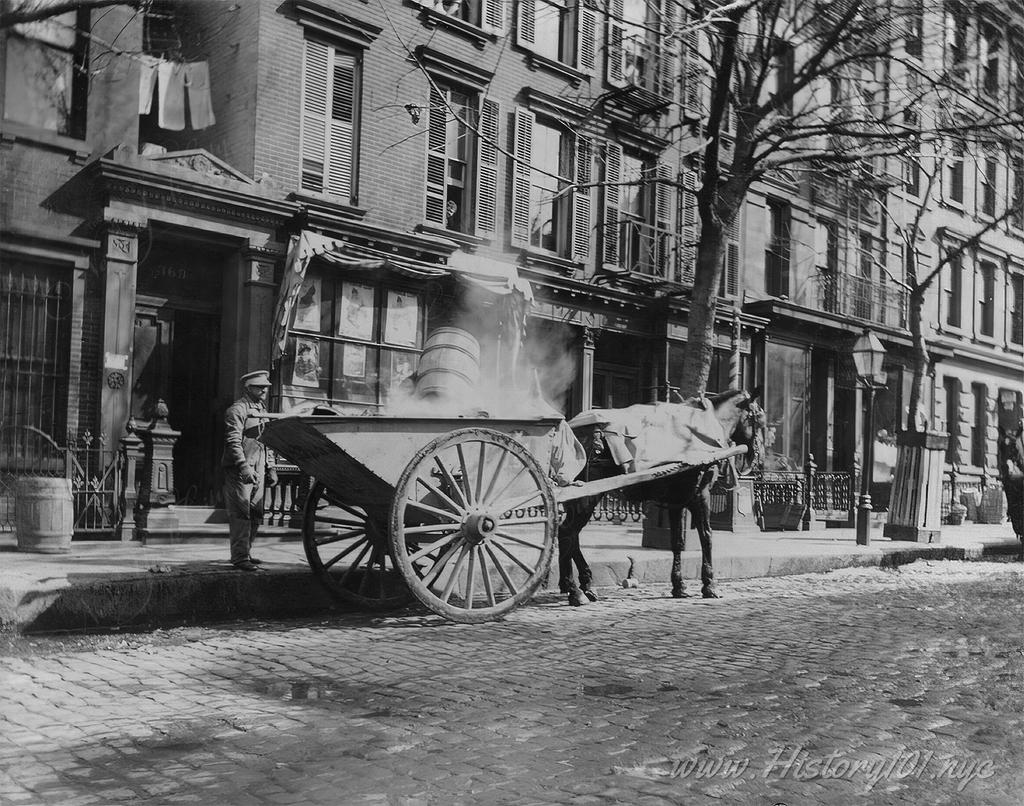
1896: Horse Drawn Ash Cart
Photograph of a horse drawn cart and a man collecting ashes from local furnaces.
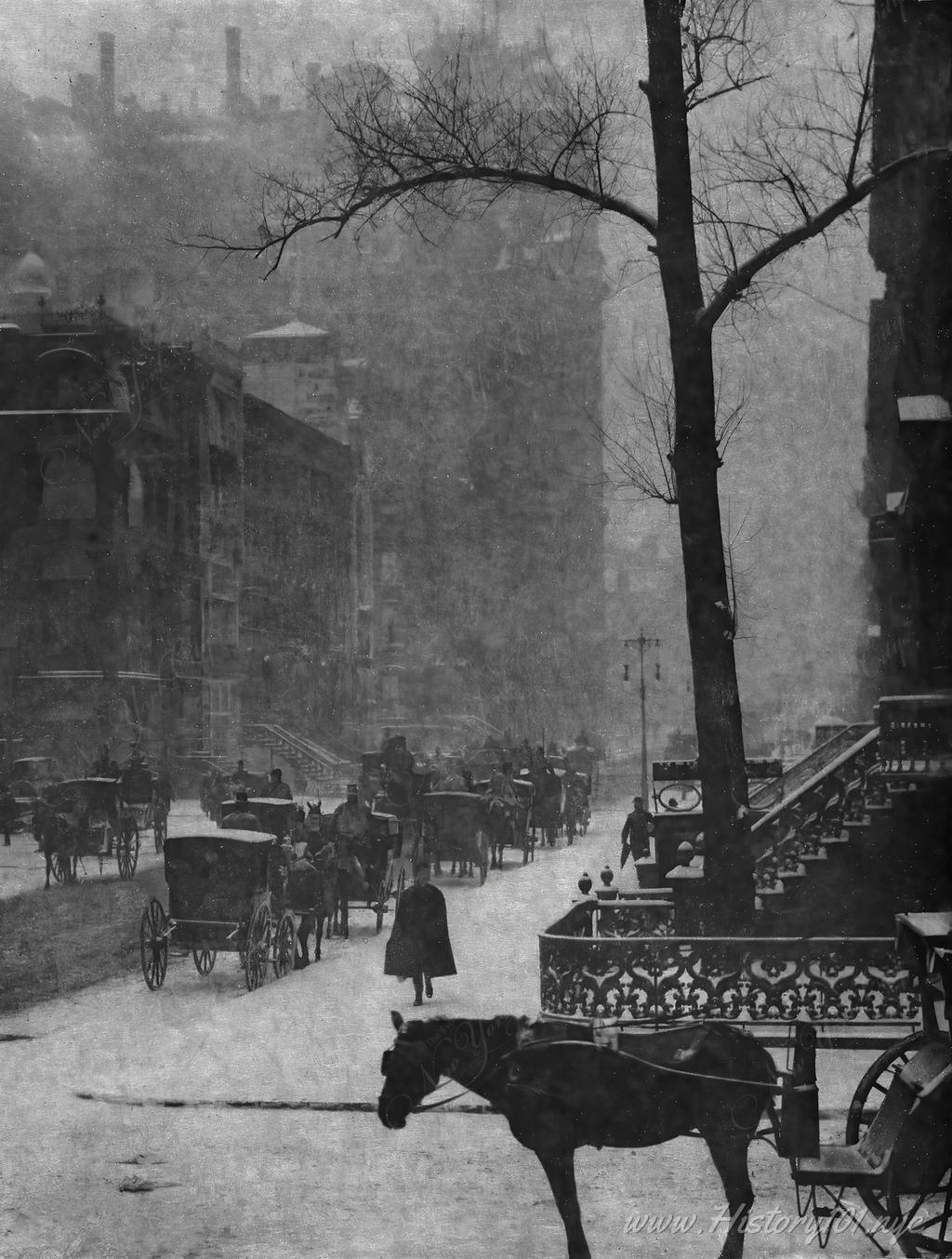
1896: Horse Drawn Carts on Madison Avenue
Photograph taken for a poster design of a winter scene looking south on Madison Avenue from 31st Street.
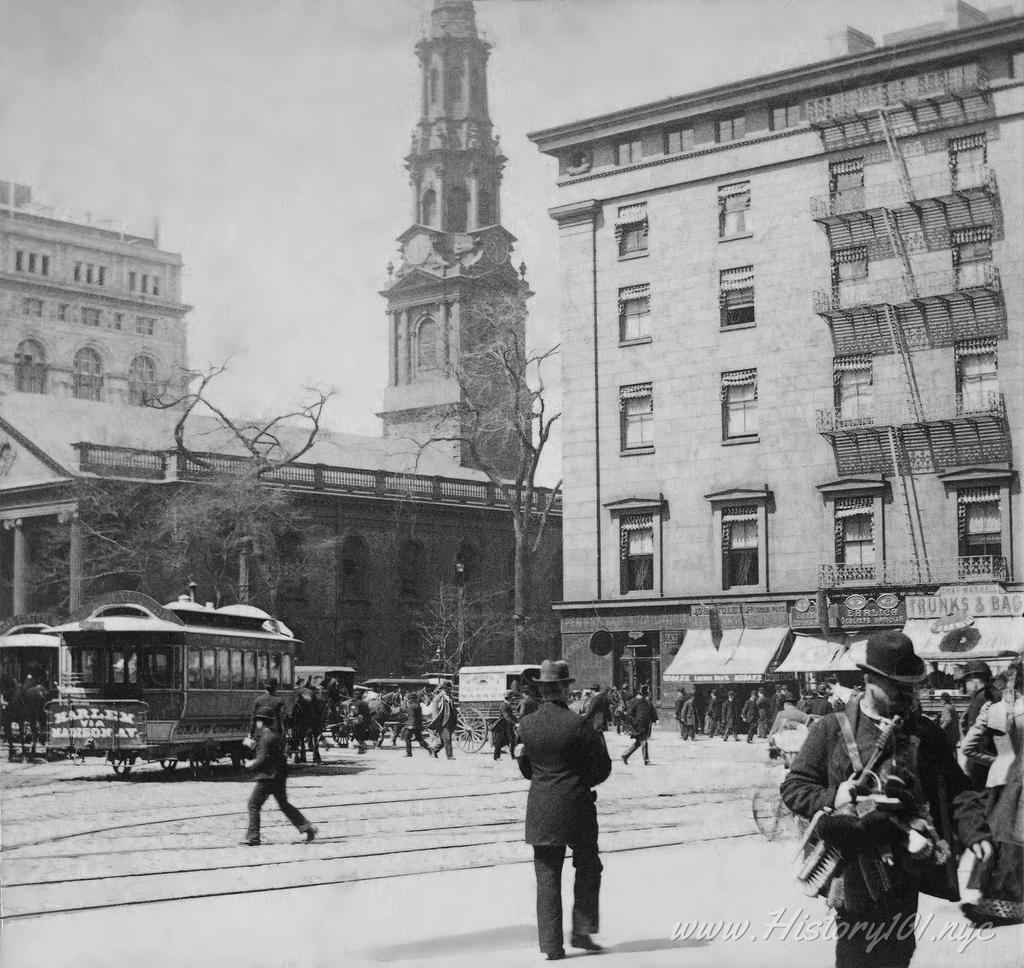
1896: Saint Paul's Church and Astor House
Photograph of a busy street in front of Saint Paul's Church and Astor House.
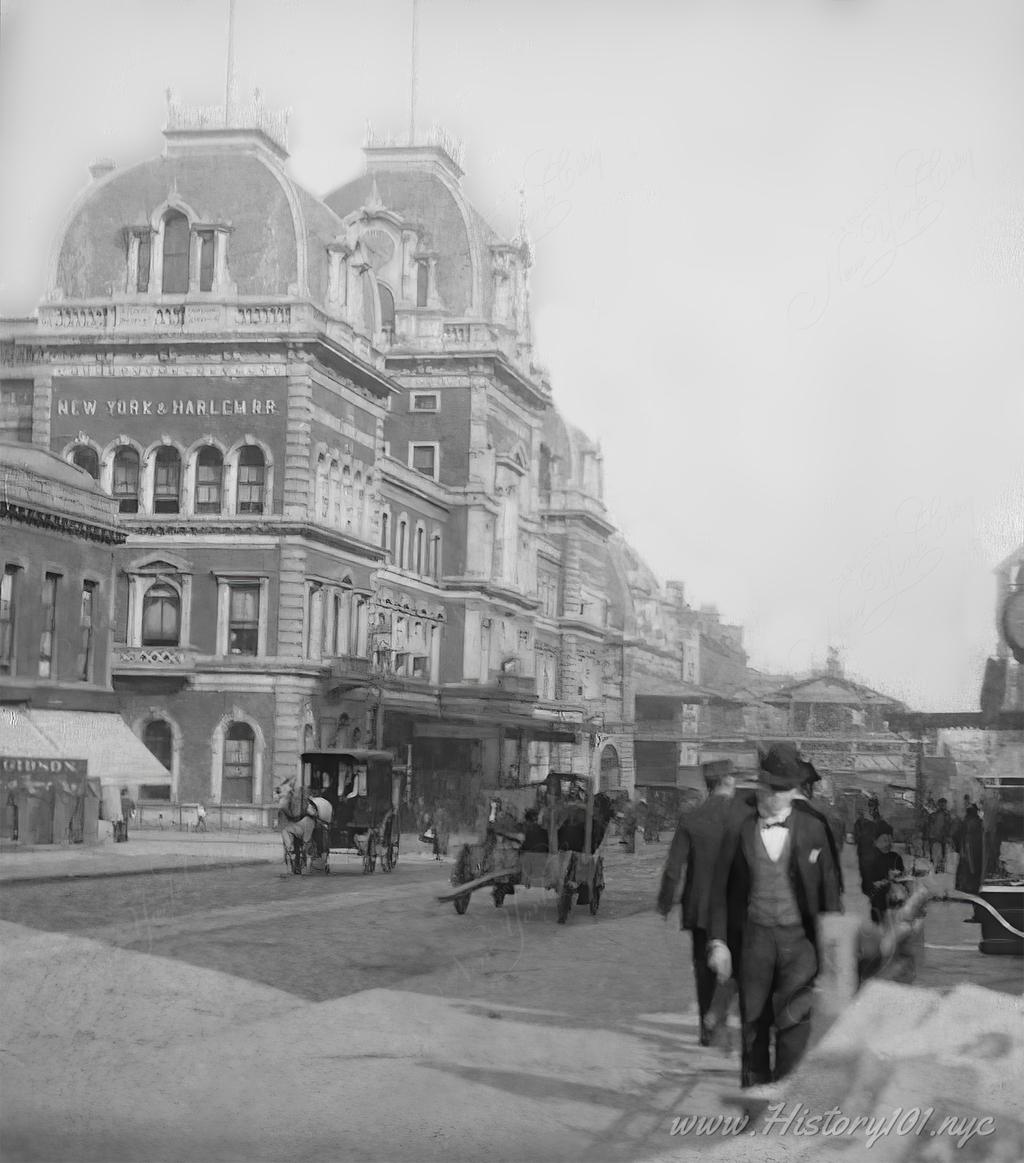
1896: Grand Central Depot
Photograph of a street scene in front of Grand Central Depot, at the time the largest interior space in the nation.
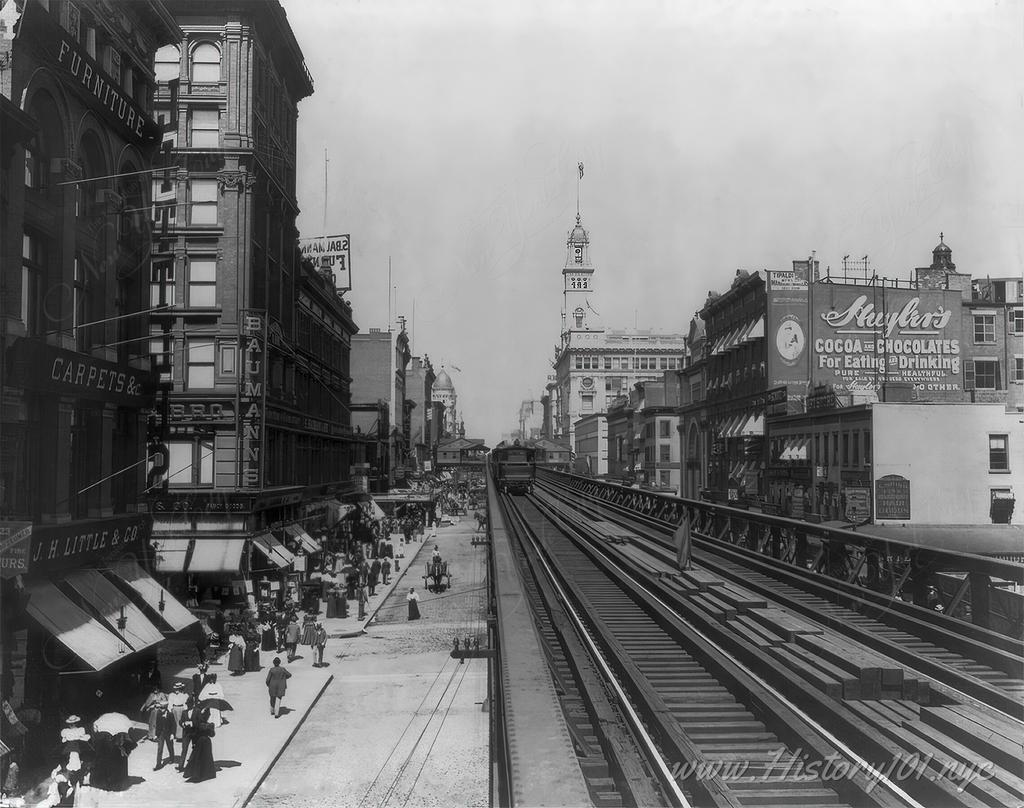
1897: 16th Street and 6th Avenue
Photograph looking down the tracks of the elevated railroad on 6th Avenue near 16th Street.
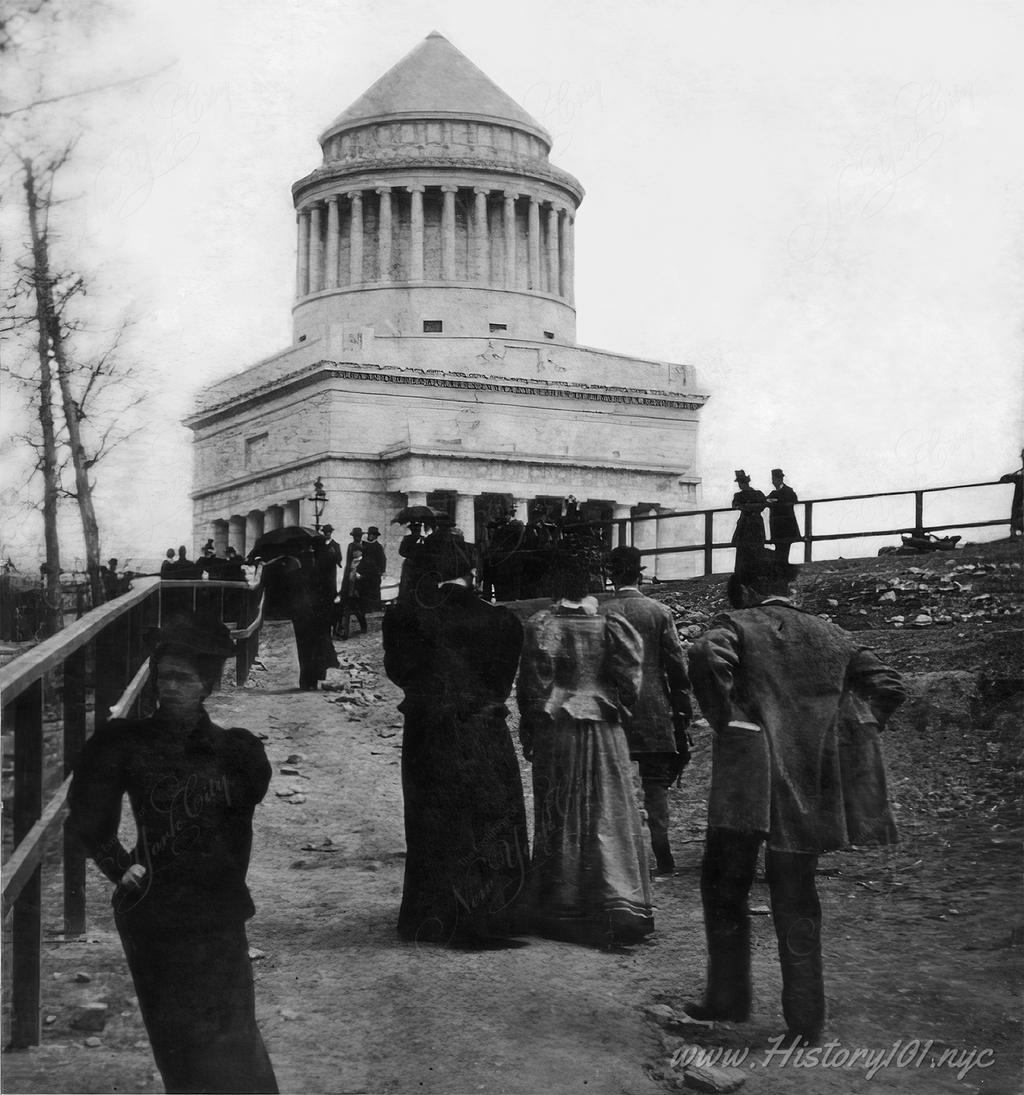
1897: Dedication of Grant's Tomb
Photograph of mourners gathering for the dedication of Grant's Tomb taken from the river front.
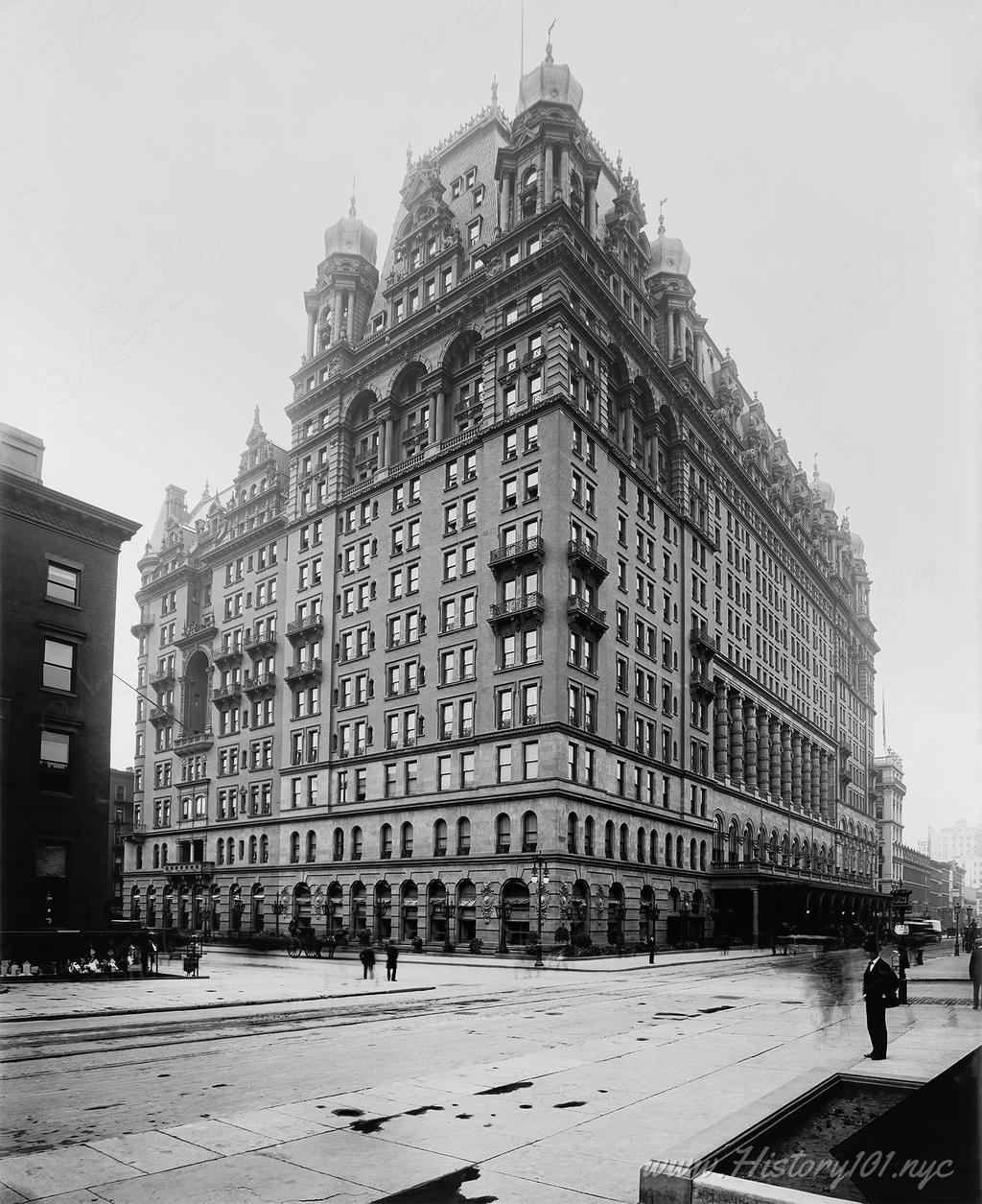
1897: Original Waldorf Astoria: A Glimpse into NYC's Luxurious Past
Discover the Waldorf Astoria's journey from its original 1893 Fifth Avenue site to the current Park Avenue landmark, embodying New York City's luxury
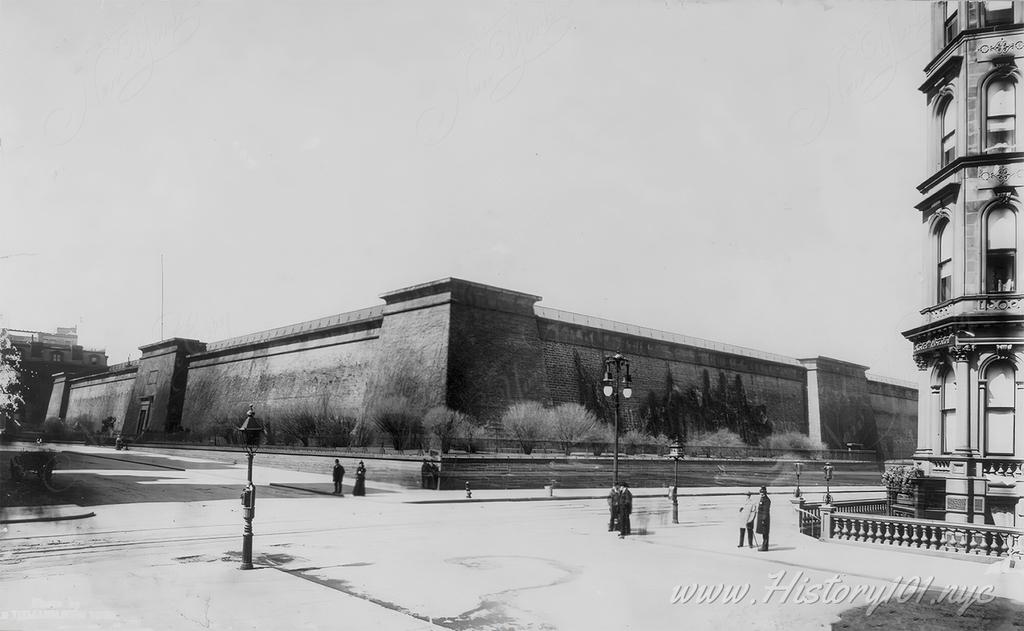
1899: The Croton Distributing Reservoir
The Croton Aqueduct water system (Murray Hill Reservoir) started construction in 1837 and opened to great fanfare on October 14, 1842.
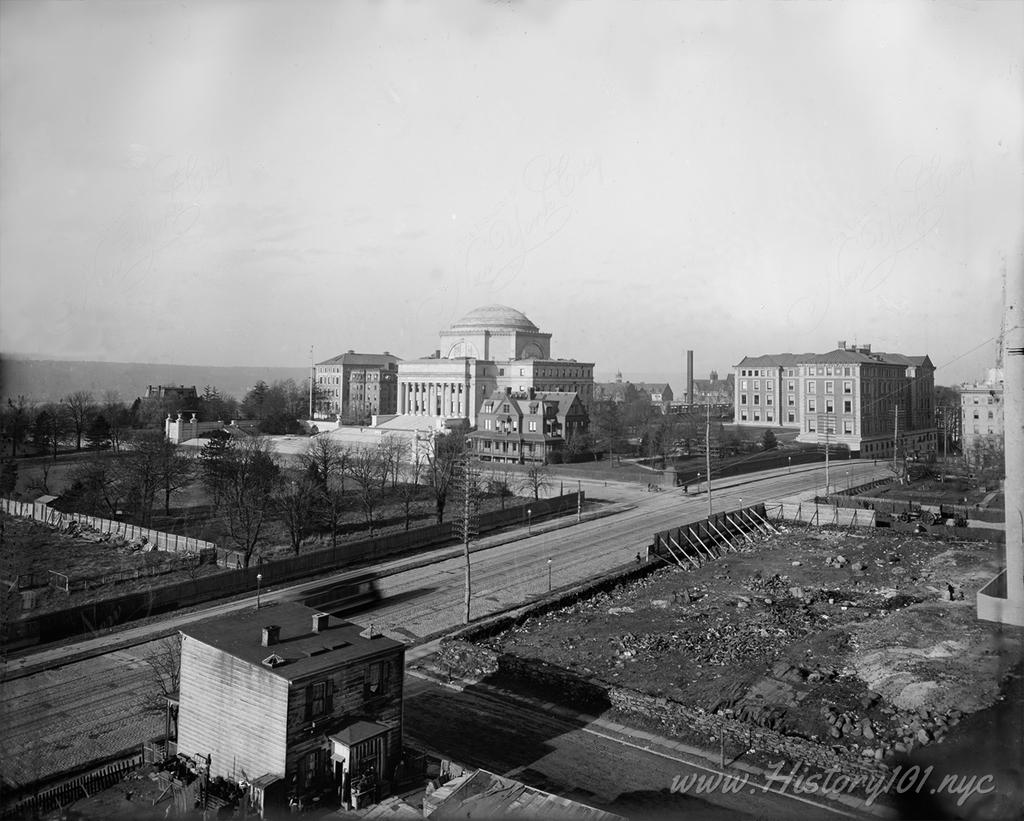
1897: Columbia College: View of Amsterdam Avenue with No Buildings
An aerial view of Columbia University campus, including Low Library and Milbank Hall.
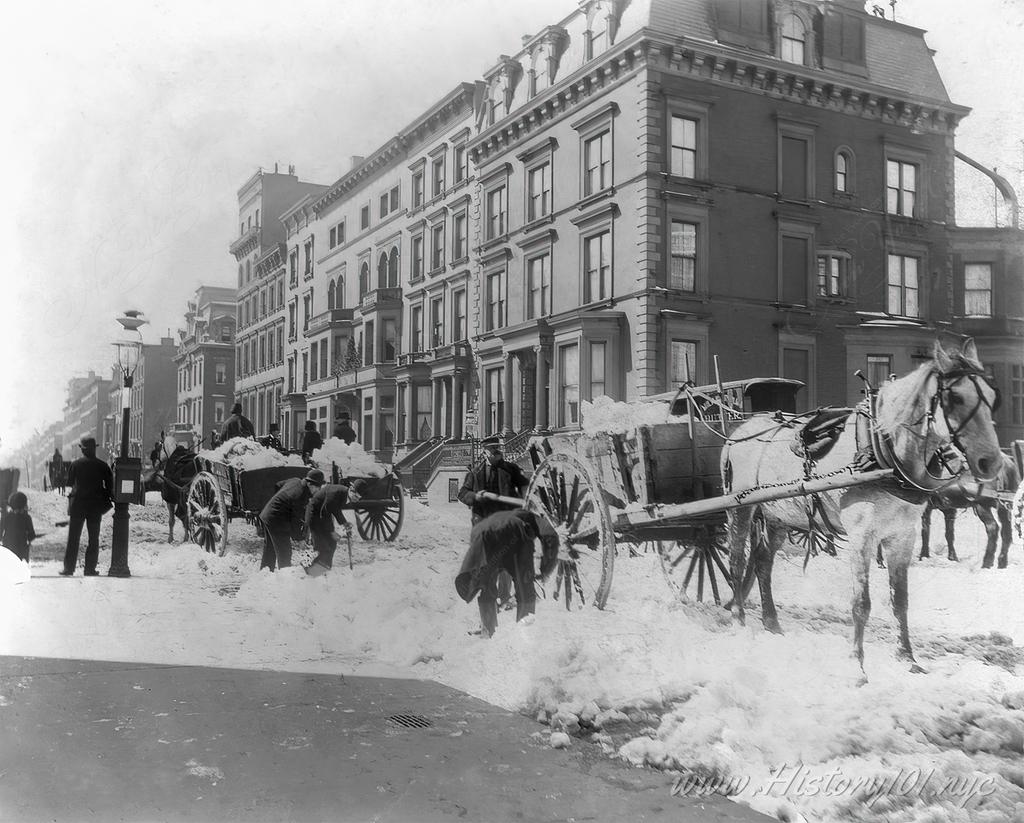
1896: Men Loading Horse-Drawn Snow Carts
Photograph of the streets after a blizzard, snow carts have been deployed to clear the roads for traffic.
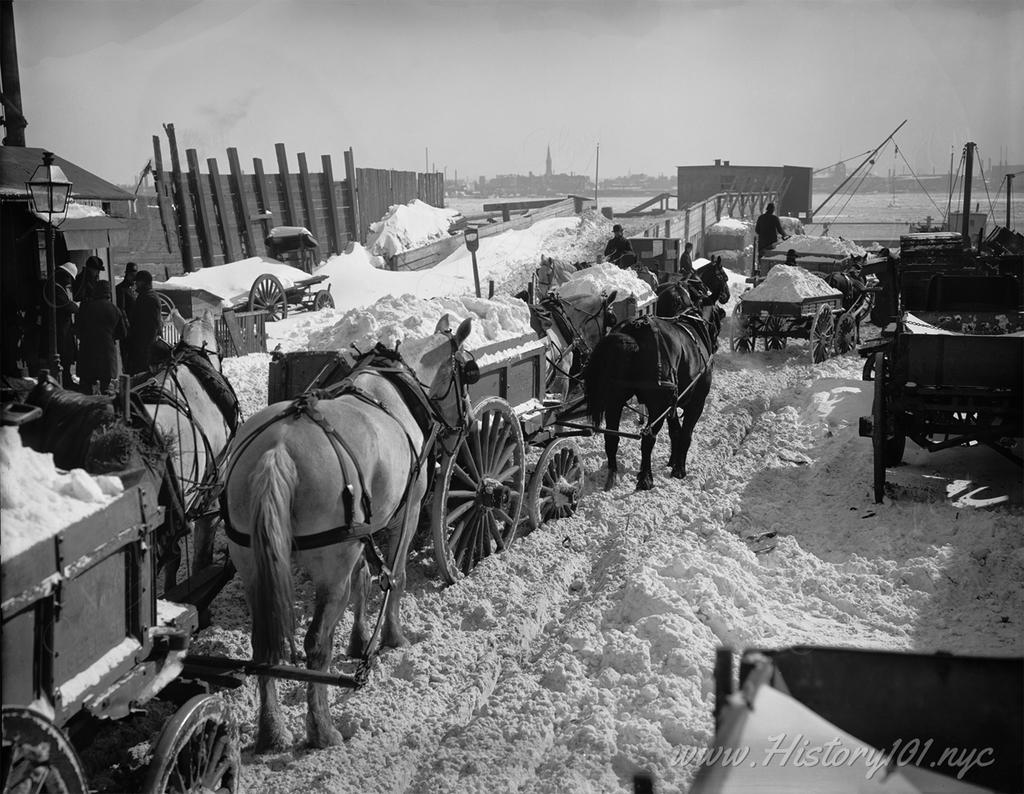
1899: Snow Carts at the river after a Blizzard
Photograph of snow carts lined up next to the river to dump snow after a blizzard.
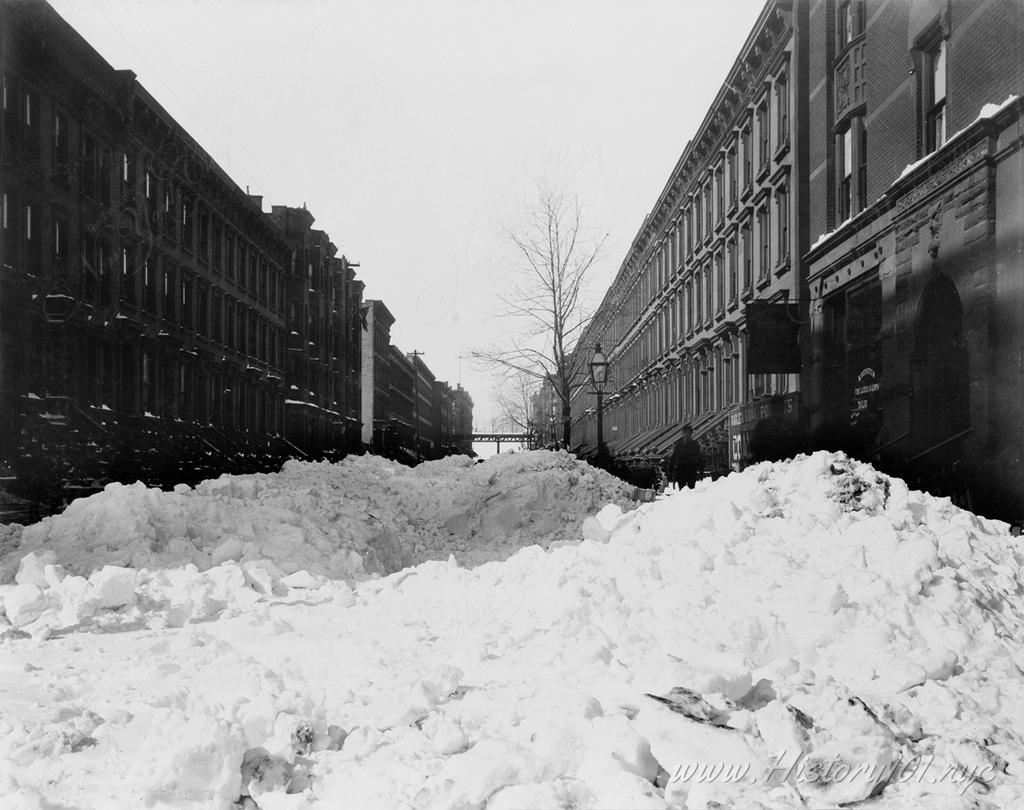
1899: Street in Harlem After a Blizzard
Photograph of a Harlem street covered in snow after the blizzard of Feb. 13, 1899.
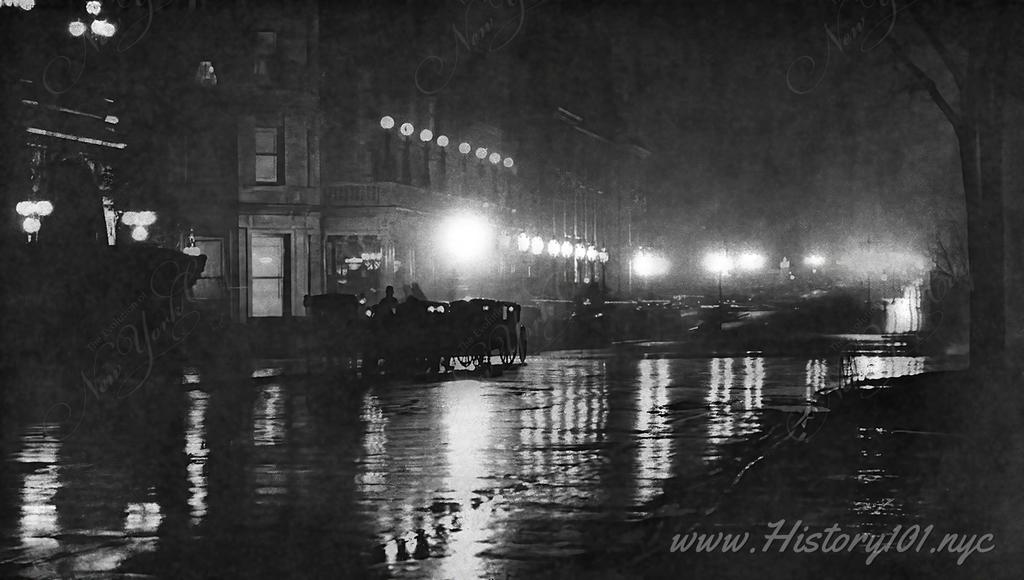
1897: The Glow of Night
Photograph of a rain soaked street, illuminated by streetlamps which are reflected on the ground.
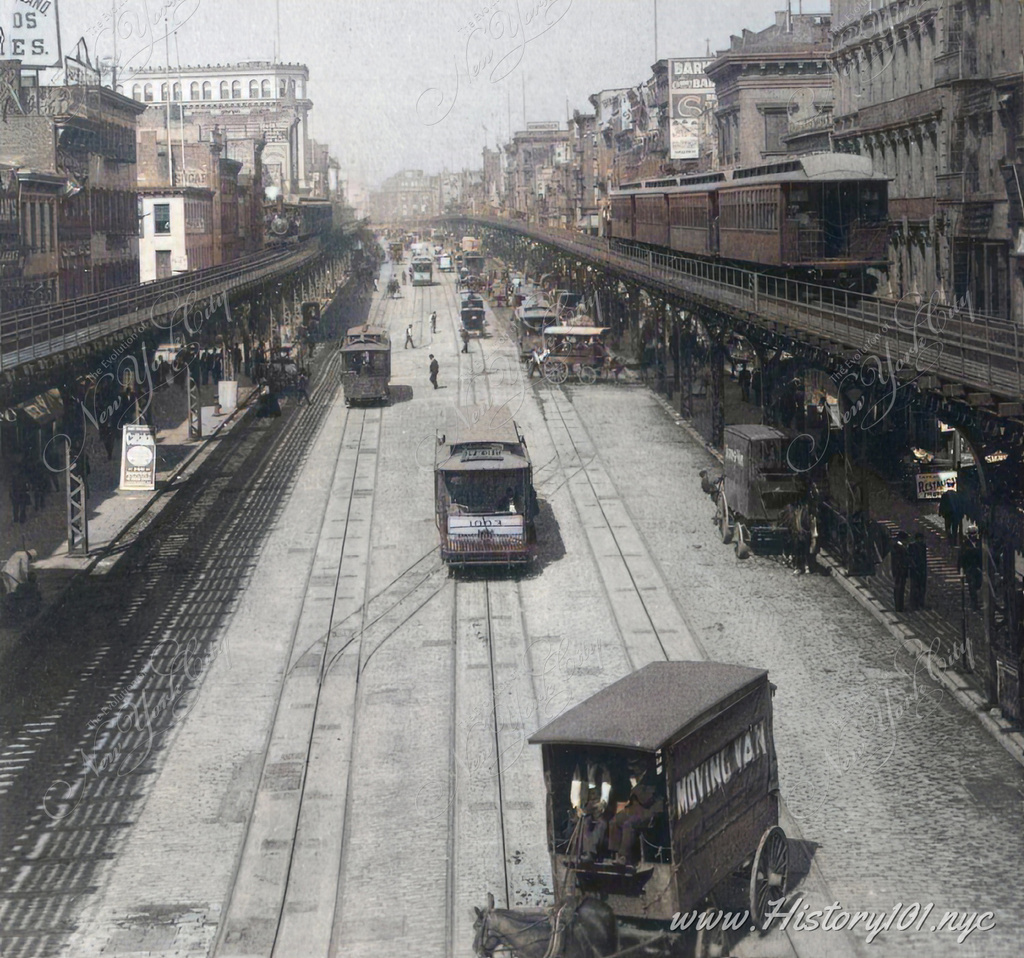
1899: The Bowery, View of The Elevated
In the year 1899, the Bowery in New York City was a vibrant mix of old and new as
Timeline of New York City: 1890-1899
1890: New York City's population surged to approximately 1,710,715 in 1890, a period marked by rapid urban growth driven by immigration and industrialization. This demographic boom reinforced the city's status as a premier urban center in the United States, reflecting its significant role in the nation's development.
This increase in population not only illustrated the physical expansion of New York City but also underscored its evolving cultural and economic landscape. The city's diverse population fostered a rich cultural mosaic, enhancing its economic dynamism and vibrancy. This critical period helped shape New York City's identity as a global hub for urban life, culture, and economy, solidifying its pivotal role in American history.
1890: Jacob Riis, a Danish-American social reformer and photojournalist, published his seminal work, "How the Other Half Lives". This groundbreaking book documented the harsh living conditions within New York City's tenements using pioneering photojournalism techniques. Riis' compelling visual and written portrayals shed light on the everyday struggles faced by the city's impoverished and immigrant populations. His work not only raised public awareness but also set the stage for social reform, highlighting the urgent need for improved housing policies.
The publication of "How the Other Half Lives" had a transformative impact on New York City's approach to social issues, spurring critical reforms in housing policies aimed at alleviating the dire conditions depicted in Riis’ photos. By bringing these issues to the forefront of public consciousness, Riis changed the landscape of journalism and social advocacy. His efforts contributed significantly to the improvement of living conditions for countless residents and influenced the development of policies designed to combat urban poverty, marking a pivotal moment in the city's history.
1890: The establishment of the United States Polo Association (USPA) on June 6, in New York City marked a significant milestone in the history of sports in America. Founded to govern the sport of polo, the USPA standardized the rules and promoted the game, enhancing its popularity among the elite. As polo was traditionally a sport associated with wealth and status, the association's presence in New York further cemented the city's reputation as a center for high society and luxury sports.
This foundation of the USPA not only enriched New York City's sporting culture but also contributed to its social fabric, attracting notable figures and prestigious events. The creation of the USPA in New York highlights the city’s influential role in shaping sports practices in the United States, reinforcing its status as a dynamic and historically significant urban center.
1890: Julius Henry Marx, known worldwide as Groucho Marx, was born in New York City, establishing a foundation that would see him rise to become one of America’s most iconic comedians. As a member of the Marx Brothers, Groucho's quick-witted humor and distinctive appearance became synonymous with innovative 20th-century comedy. His early years in the vibrant cultural landscape of New York played a crucial role in shaping his comedic style, which would later revolutionize entertainment with its unique blend of irreverence and satire.
Groucho Marx was born on October 2, and his journey from New York vaudeville stages to national stardom epitomizes the city's capacity to launch influential careers in the arts. His work, especially the vaudeville performances and Broadway shows that later transitioned into film, reflects the eclectic and dynamic spirit of New York City during the early 20th century. This connection not only highlights the city's pivotal role in the evolution of modern comedy but also underlines its significance as a hub for artistic innovation that resonates globally.
1890: Paul Strand, a seminal figure in the development of modernist photography, was born on October 16, in Brooklyn, New York. His innovative approach and technical proficiency helped elevate photography to a fine art form during the early 20th century. Strand's work, characterized by its stark realism and compositional rigor, captured the complexities of the human condition and the stark beauties of the natural world. His contributions significantly shaped the visual arts scene, leaving a lasting imprint on both photography and filmmaking.
The influence of Paul Strand extends deeply into the cultural fabric of New York City, where he first honed his craft. His explorations around the city resulted in iconic images that offer a historical snapshot of urban life during a transformative era for both the metropolis and the art of photography. Born in Brooklyn, Strand's early experiences in New York not only influenced his artistic direction but also highlighted the city's role as a nurturing ground for innovative art and ideas. Through his lens, New York served as both muse and backdrop, helping to establish the city's enduring legacy as a center for the creative arts.
1890: Edwin Howard Armstrong, an influential American inventor and radio pioneer, made significant contributions to the development of modern communication technologies. Born in New York City, Armstrong's work fundamentally changed the landscape of radio broadcasting through his invention of frequency modulation (FM). His pioneering efforts in improving radio signal quality and reducing interference transformed how information and entertainment were transmitted globally, establishing foundational techniques that are still used in radio communications today.
Armstrong was born on December 18, in New York City, where he later developed FM radio—an innovation that enhanced sound quality over the airwaves dramatically. This breakthrough, achieved in the bustling environment of New York, not only showcased the city's capacity to foster innovation but also cemented its reputation as a leader in technological advancements. The success of his invention had a profound impact on New York City's cultural and technological heritage, affirming its status as a dynamic hub for pioneering scientific research and development.
1891: Carnegie Hall, designed by William Burnet Tuthill and funded by the philanthropist Andrew Carnegie, was inaugurated and quickly ascended to prominence as a premier venue for classical music on a global scale. Located in New York City, the hall is celebrated for its outstanding architectural and acoustical qualities, which have made it a beloved landmark among music enthusiasts worldwide. The dedication to fostering exceptional musical performances has consistently drawn some of the most famous figures in music, enhancing its reputation as a cultural treasure.
The opening of Carnegie Hall was marked by a grand inaugural concert featuring the renowned Russian composer Peter Ilyich Tchaikovsky on May 5. This event not only highlighted the hall's significant role in the classical music world but also reinforced New York City's stature as a major cultural center. The presence of an international music luminary like Tchaikovsky at the inauguration brought immediate international acclaim to the venue, elevating the city's global cultural profile and affirming its place as a vital hub in the classical music sphere. This auspicious beginning set the stage for Carnegie Hall to become synonymous with musical excellence, contributing richly to New York City’s cultural and architectural legacy.
1891: Gristedes began as a small grocery store by brothers Diedrich and Charles Gristede, and over the years, it has evolved into a prominent supermarket chain in New York City. Initially focused on providing quality food products, the chain has played a key role in the retail sector, reflecting the city's evolving commercial landscape.
Gristedes' growth from a local store to a significant supermarket chain mirrors New York City's broader commercial development, showcasing trends in growth and modernization. For over a century, it has been a vital part of the city's everyday life, significantly contributing to the local economy and fulfilling the daily needs of New York City's residents.
1891: The opening of the first public bathhouse with showers in New York City, known as the People's Bath, marked a significant milestone in urban public health. Introduced on August 17, this facility was designed to provide essential hygiene services to the city's less fortunate residents, many of whom lacked access to adequate sanitation in their own homes. The establishment of the People's Bath represented a progressive step towards improving living conditions and addressing public health concerns among New York City’s burgeoning population, particularly those living in crowded and unsanitary tenements.
The People's Bath not only offered a practical solution to the hygiene challenges faced by many New Yorkers but also played a pivotal role in the broader movement towards urban sanitation reform. By providing a place where individuals could maintain cleanliness, the city took a proactive approach to prevent the spread of diseases, which were rampant in the overcrowded living conditions of the time. This initiative highlighted New York City’s commitment to enhancing the quality of life for all its residents, reinforcing its status as a leader in innovative urban planning and public health advancements.
1891: On September 14, the "Empire State Express" of the New York Central Railroad made a groundbreaking journey, setting a record for the fastest train trip from New York City to East Buffalo. Covering a distance of 436 miles in just 7 hours and 6 minutes, this event showcased the impressive capabilities of American rail technology and the potential for rapid long-distance rail travel. The train's record-setting performance was a testament to the innovations and engineering prowess of the period, emphasizing the role of railroads in revolutionizing transportation and shaping the economic landscape of the United States.
The remarkable speed of the "Empire State Express" not only marked a technological triumph but also underscored New York City's pivotal role in the nation’s transportation network. This historic run enhanced the city's status as a major transportation hub, connecting it more efficiently with other key economic centers across the region. By facilitating quicker travel times, the "Empire State Express" helped boost economic activities, fostered greater mobility, and contributed to New York City's growing influence as a commercial powerhouse. The event remains a significant milestone in the history of rail travel, reflecting the city's enduring legacy in leading transportation innovations and supporting the nation's industrial expansion.
1891: The George Batten Company began in New York City as a modest advertising business in a small room at 38 Park Row. Founded by George Batten and Margaret Hopkins, it set the foundation for what would evolve into the globally recognized agency BBDO. The company's dedication to high standards and ethical practices significantly shaped the advertising profession's reputation.
This pioneering agency merged with Barton, Durstine, and Osborn on September 15, 1928, forming Batten, Barton, Durstine, and Osborn, Inc. (BBDO). This merger marked a significant moment in advertising history, exemplifying the evolution of advertising as a key business sector and setting the tone for industry consolidations. The legacy of the George Batten Company, now integral to BBDO, continues to influence the advertising world and contributes to New York City’s rich commercial narrative.
1892: Ellis Island, nestled in New York Harbor, started as the principal U.S. immigrant inspection station, serving as a vital gateway for over twelve million individuals until 1954. The island was first to welcome Annie Moore, a 15-year-old from Ireland, who arrived via the steamship Nevada on January 1, marking her as the first immigrant processed at the opening.
Dubbed the "Island of Tears," Ellis Island was a place of profound emotional experiences for many who passed through, oscillating between hope and despair. The last person processed here was Arne Peterssen, a Norwegian merchant seaman, marking the end of its operations. This journey from Annie to Arne captures the rich mosaic of human stories woven into the fabric of Ellis Island's historic legacy, bookending an era of immense cultural convergence.
1892: The Washington Square Arch was originally a temporary wooden structure erected for the centennial celebration of George Washington's inauguration in 1889. It was designed by McKim, Mead, and White. Its success led to the creation of a permanent marble version to commemorate the first President's 100th anniversary.
Stanford White, from the same architectural firm, designed the enduring marble version, and its construction took place from 1890 to 1892. The completed arch still stands in Washington Square as a prominent New York City landmark, representing the city's deep historical connections and architectural heritage.
1892: New York City established its first Buildings Department to address rapid urbanization and the construction boom, responding to the burgeoning needs for regulation and safety in building construction. This move was essential in Manhattan, where substantial growth was fueled by industrialization and immigration.
The creation of the Buildings Department significantly enhanced building safety and compliance with construction standards, mitigating risks associated with poorly constructed structures. It played a crucial role in regulating the city's urban expansion, ensuring orderly and sustainable development. This pivotal development, marked a turning point in New York City's urban history, laying the foundation for modern building regulations and urban planning practices.
1892: The Decker Building, located at 33 Union Square West in Manhattan, epitomizes architectural diversity in New York City. Designed by John H. Edelmann for the Decker Brothers, its notable façade showcases the unique Art Nouveau style, a rarity in the city's architectural landscape at the time. This design choice marks it as an architectural gem in a city known for its eclectic buildings.
Strategically positioned in Union Square, the Decker Building embodies the commercial and cultural dynamism of late 19th-century New York. It stands as a testament to the area's vibrant economic activity and cultural significance, adding a distinct element to the city's historical and architectural tapestry. Its completion enhanced Union Square's role as a hub of urban energy and artistic expression.
1892: Jesse Reno, an American engineer, made a significant technological contribution that would change public spaces and transportation hubs forever. On March 15, he patented the first escalator, which he originally called an "inclined elevator." This innovative design was first introduced to the public not as a practical transport solution but as a novel amusement ride. It made its debut later in the year at the Old Iron Pier in Coney Island, New York City, where it added to the area's array of attractions, drawing considerable attention from visitors intrigued by this new form of motion.
The introduction of Reno's escalator at Coney Island on September 16, 1892, not only marked a playful start to a significant invention but also set the stage for its practical applications in more conventional settings. The success of this initial installation demonstrated the escalator's potential to enhance urban mobility. Over time, this invention became integral to New York City's infrastructure, particularly in subway stations and multi-story buildings, facilitating efficient pedestrian flow and accessibility. Reno's invention continues to impact daily life in the city, underscoring New York's historic role as a crucible of innovation and its capacity to integrate new technologies into the urban fabric.
1892: Constructed in 1854, Litchfield Villa stands as a quintessential example of Italianate architecture designed by Andrew Jackson Davis. Located in Prospect Park, Brooklyn, the villa was originally built for Edwin Litchfield, a prominent railroad developer. Post-Civil War, Litchfield played a crucial role in the development of Prospect Park by donating approximately 24 acres of his estate to the public park. This generous contribution significantly enhanced the park's landscape, integrating a piece of architectural history into Brooklyn’s public realm. In 1869, the City of Brooklyn officially acquired the villa, further solidifying its integration into the park's environment.
In 1892, the Litchfield Villa was repurposed as the headquarters for the Brooklyn Parks Department, a move that has been pivotal in preserving the historic building and maintaining its role within the community. This ongoing use not only ensures the upkeep and continued relevance of the villa but also highlights its enduring significance in Brooklyn's and New York City’s broader cultural and historical narrative. By housing the Parks Department, the villa continues to serve a public function, contributing to the administrative and cultural life of the city, thereby reaffirming its status as a historic landmark and a center of community activity in Brooklyn.
1892: Vogue was launched by Arthur Baldwin Turnure as a weekly newspaper in New York City, initially targeting the city's elite with content centered around high society, fashion, and culture. Over the years, Vogue evolved from a newspaper format into one of the world's leading fashion magazines, significantly shaping the fashion industry and media. This transformation reflected the dynamic cultural evolution of New York City, as the magazine became a trendsetting publication that influenced global fashion and lifestyle trends.
The establishment of Vogue marked New York City as a burgeoning hub for fashion and media, reinforcing its status as a center for cultural innovation. As Vogue grew in stature and influence under the leadership of figures like Anna Wintour, it played a pivotal role in shaping the media and publishing landscapes, not only in New York but around the world. The magazine's success underscores the city’s influential role in global fashion trends, notably during events like New York Fashion Week, and its ability to shape international media landscapes, cementing New York City's place in the annals of cultural history and as a leader in the global fashion industry.
1892: Founded by Clara B. Spence, the Spence School in New York City emerged as a pioneering institution for women's education. At a time when educational opportunities for women were scarce, it represented a progressive shift, focusing on rigorous academics and personal development. The school quickly gained recognition for its commitment to intellectual growth and academic excellence.
The Spence School's contribution to New York City's intellectual and cultural fabric has been significant. By nurturing generations of women who have made impactful contributions across various fields, the school has played a vital role in the city's educational and cultural advancement. Its enduring commitment to empowering young women through education has established it as a distinguished and influential institution within the city's educational landscape.
1892: The Patrolmen's Benevolent Association (PBA) was established in New York City and represents a landmark in the history of labor unions for law enforcement. Serving as a labor union for NYPD patrol officers, it has become one of the oldest and largest of its kind in the U.S., advocating for officers' rights, benefits, and improved working conditions.
The PBA's inception significantly advanced labor relations within New York City's public sector, marking a pivotal moment in the evolution of unionization and labor rights for police personnel. The association's work has been crucial in promoting police welfare, impacting law enforcement effectiveness and public safety in the city, and contributing to the historical narrative of labor movements and unionization in New York City.
1892: The New York School of Applied Design for Women, established in New York City, significantly advanced women's education. It focused on providing women with professional education in art and design, addressing the educational disparity in these fields. This institution emerged as a trailblazer in promoting women's active participation in art and design.
The school's establishment played a key role in empowering women in New York City, offering them vital training and opportunities, and contributing to the women's rights movement. It enriched the city's cultural and artistic diversity by nurturing female talent in the arts, thereby enhancing its cultural dynamism. The New York School of Applied Design for Women remains a testament to the city's progressive stance on women's education and its cultural richness.
1892: The City Island Yacht Club (CIYC) stands as a vital part of New York City's maritime history, enhancing its cultural and recreational heritage. Its commitment to community outreach, supporting maritime and environmental efforts, underscores its significance beyond a sailing hub.
CIYC has been pivotal in shaping NYC's sailing culture, hosting events like the Knickerbocker Cup and North American Star Championship, thereby influencing the city's identity. Economically, it boosts the local economy, attracting enthusiasts and offering unique experiences near the urban landscape. Its continuous operation preserves maritime traditions, contributing to NYC's diverse historical tapestry. CIYC is more than a recreational spot; it's a historical entity enriching NYC's cultural, social, and economic realms.
1892: The City Club of New York, initiated by leaders like August Belmont Jr. and James C. Carter, aimed to enhance local governance in New York City. It focused on promoting transparency and independence in municipal administration. The club's early efforts targeted diminishing the influence of the Tammany Hall political machine and later expanded to urban planning and preservation.
The City Club has significantly influenced New York City's political and social spheres, engaging in various campaigns for historical preservation and urban safety. Its enduring commitment to civic engagement and policy advocacy has been pivotal in shaping the city's development and improving residents' quality of life.
1892: The Cathedral of St. John the Divine, a masterpiece of Gothic Revival and Romanesque Revival architecture, is a cornerstone of New York City's cultural and spiritual community. Since laying its foundation stone in 1892, this Manhattan landmark has grown to become one of the largest Christian churches in the world, despite being famously known as "St. John the Unfinished" due to its ongoing construction. The cathedral not only serves as a place of worship but also as a vibrant center for the arts, hosting numerous cultural and civic events that enhance its role within the city’s rich social tapestry.
The initial groundbreaking on December 27, was a monumental event in New York City's history, symbolizing a deep commitment to religious and cultural diversity. This ongoing development mirrors the dynamic evolution of the city, reinforcing its reputation as a global center of architectural grandeur and cultural diversity. The cathedral’s integration into New York’s historical fabric has been significant, contributing enduringly to its cultural heritage. Additionally, the cathedral's once-resident peacocks, introduced in the 1980s and recently moved to a sanctuary in 2024, added a unique charm to its grounds, symbolizing peace and renewal. This thoughtful transition highlights the cathedral's continued commitment to both its community and environmental stewardship, maintaining its status as an iconic, compassionate presence in the heart of the city.
1893: The Municipal Art Society of New York (MAS), has significantly influenced New York City's urban planning, architecture, and cultural preservation. Its mission to enhance city livability and aesthetics has led to dedicated advocacy in urban development, preservation of historic buildings, and beautification of public spaces, profoundly impacting the city's architectural and cultural dynamics.
MAS's role has been pivotal in preserving New York City's architectural heritage, ensuring the maintenance of numerous historic buildings and landmarks. Through promoting better urban planning and design, MAS has elevated the city's stature as an innovator in urban development, underscoring its dedication to enhancing urban life quality and safeguarding historical and cultural assets.
1893: On December 16, Antonín Dvořák's "New World Symphony," officially Symphony No. 9 in E Minor, premiered at Carnegie Hall in New York City. Composed during his tenure as the director of the National Conservatory of Music of America, this symphony encapsulates Dvořák's experiences in the United States, merging American musical elements with European symphonic traditions.
The debut of the "New World Symphony" marked a pivotal moment in New York City's cultural history, enhancing its reputation as a hub for classical music. Attracting international composers like Dvořák, the city demonstrated its growing influence in the arts. This symphony, celebrated for its unique blend of musical styles, became one of Dvořák's most renowned works, exemplifying New York City's role in promoting cultural and artistic innovation at the century's turn.
1893: On August 24, the New York area was struck by a catastrophic hurricane, leading to the total destruction of Hog Island and causing a massive 30-foot storm surge. This event, resulting in extensive coastal damage and at least 34 fatalities, marked a significant weather event in the region's history due to its unprecedented severity.
The hurricane underscored New York City's susceptibility to natural disasters, especially severe coastal storms, and highlighted the urgent need for enhanced storm preparedness and response strategies. The complete annihilation of Hog Island exemplified the immense power of natural forces to dramatically transform landscapes. This event remains a pivotal part of New York City's historical narrative, demonstrating the challenges of natural disasters and underscoring the importance of resilience and proactive planning in disaster management.
1893: The World's Columbian Exposition in Chicago catalyzed a neoclassical and Beaux Arts architectural revival in the United States, significantly impacting New York City's architectural landscape. This movement led to the construction of several prominent public buildings, marking a notable shift from previous architectural norms in the city.
This revival also transformed New York City's parks, integrating monumental architecture where it was previously rare. Key examples include Brooklyn's Grand Army Plaza's Soldiers and Sailors Memorial Arch (1892), Riverside Park's Grant's Tomb (1897), Fort Greene Park's Prison Ship Martyrs' Monument (1908), and Central Park's Battleship Maine Memorial (1913). These landmarks exemplify the lasting influence of the Exposition on New York City's architectural and cultural fabric.
1894: The New York State Constitutional Convention led to pivotal changes in state governance, fundamentally altering the political landscape. During this convention, significant adjustments were made to the legislative structure to ensure equitable representation across the state. The Senate was expanded from 32 to 50 seats, with specific provisions to prevent any one area, particularly New York City and Brooklyn, from having disproportionate influence; no more than one-third of the senators could come from New York City, and no more than one-half from both New York City and Brooklyn combined. Additionally, the number of Assembly seats was increased from 128 to 150, with each county guaranteed at least one representative, except for Hamilton and Fulton counties, which were to share a single seat.
Further governance reforms introduced at the convention included mandates to enhance legislative transparency and operational efficiency. It was decreed that legislative bills must be printed at least three days before their passage, providing lawmakers and the public ample time to review proposed legislation. The electoral schedule was also reorganized, with state elections set for even years and municipal elections for odd years, streamlining the electoral process and reducing voter fatigue. Moreover, the governor’s term was adjusted from three to two years, aligning it more closely with broader electoral cycles. These reforms, initiated during the convention held on May 8, have had a profound and lasting impact on how New York State, including its major municipalities like New York City, governs and represents its citizens.
1894: On September 4, New York City witnessed a significant labor movement as 12,000 tailors went on strike to protest the inhumane conditions prevalent in sweatshops. This large-scale strike was a critical moment in the labor rights movement, drawing attention to the plight of workers in the garment industry, which was a cornerstone of the city’s economic life. The tailors’ strike highlighted the urgent need for reforms in labor practices, spotlighting the harsh realities faced by workers in their fight for fair treatment and better working conditions.
The strike not only brought the issues of worker exploitation and unsafe working environments to the forefront of public consciousness but also set the stage for future labor reforms in New York City. By showcasing the collective power of workers, the 1894 tailors' strike played a pivotal role in shaping labor laws and improving the conditions under which many New Yorkers worked. This event remains a significant part of New York City's history, reflecting the city’s ongoing evolution as a leader in social reform and labor rights activism.
1894: Established on September 23, by Italian immigrant Antonio Veniero, Veniero's Pasticceria in New York City's East Village has become a renowned culinary institution. Known for its authentic Italian pastries and commitment to traditional baking methods, Veniero's has been a staple in the local community, attracting both residents and tourists with its quality offerings.
As one of New York City's oldest bakeries, Veniero's Pasticceria symbolizes the rich culinary heritage of Italian immigrants and stands as a cultural landmark in the East Village. Its sustained popularity and success reflect the city's diverse cultural tapestry and status as a culinary hub. The bakery's deep-rooted history and community connection continue to make it a beloved and integral part of the neighborhood's
1894: The United States Golf Association (USGA) was officially established to serve as the governing body for the sport of golf in the United States, with responsibilities including standardizing rules and overseeing amateur status. Founded to unify the rules of the game across American golf clubs, the USGA was instrumental in shaping the modern game of golf, promoting its growth and ensuring its integrity. The association's formation marked a significant step in the formalization of golf, transitioning it from a casual pastime to a structured sport with nationwide competitive standards.
On December 22, New York City became the birthplace of the USGA, emphasizing the city's role as a catalyst in sports development and its influence on national sports culture. This establishment not only bolstered New York City’s status as a hub for sporting innovation but also contributed to its rich cultural and historical fabric. The presence of the USGA headquarters in the city for many years thereafter reinforced New York’s position as a leader in the sports industry, enhancing its reputation and attracting golf enthusiasts and events, thereby enriching the city’s economy and sports heritage.
1895: New York City witnessed a groundbreaking moment in entertainment history with the first commercial movie performance, establishing it as a pioneering city in the emerging film industry. This event took place at 153 Broadway, where attendees experienced the novel thrill of motion pictures. The screening signified the commercial inception of cinema, setting the foundation for the movie industry's expansive growth. As a forerunner in this new entertainment medium, New York City quickly became a center for cinematic innovation, attracting talent and audiences eager to partake in the film-watching experience. This early adoption of film technology underscored the city's role as a trendsetter in cultural and technological developments.
The historical screening occurred on May 20, marking a notable date in both New York City's and America's cultural timelines. This premiere not only captivated audiences but also sparked the proliferation of movie theaters across the city, contributing significantly to the urban cultural scene and the economy. New York City's early embrace of film technology showcased its capacity to influence global entertainment trends and reinforced its status as a dynamic metropolis rich in cultural innovation. The enduring impact of this event continues to resonate, affirming New York City's pivotal role in the birth and growth of the cinema industry.
1895: Founded on May 23, the New York Public Library (NYPL) emerged from the merging of the Astor and Lenox libraries and the Tilden Trust, creating a landmark institution in New York City. The NYPL, housing vast collections of books, manuscripts, and educational materials, quickly rose to prominence as a leading public library in the United States.
The NYPL's main branch, opened in 1911 at Fifth Avenue and 42nd Street, is renowned for its iconic architecture and lion statues, Patience and Fortitude. This institution has significantly boosted New York City's access to knowledge and learning, offering diverse programs and services for education and community engagement. Its role in intellectual development and cultural preservation has cemented the NYPL as a cornerstone in New York City's historical narrative.
1895: Sea Lion Park opened in Coney Island, pioneering the American amusement park industry with novel features like the Flip Flap Railway, one of the nation's first looping roller coasters. Conceptualized by Paul Boyton, it revolutionized the sector by charging a fixed admission fee, a departure from the norm.
Sea Lion Park's introduction significantly boosted Coney Island's status as a prime recreational spot, influencing the evolution of leisure in New York City. It not only set a precedent for subsequent amusement parks but also played a key role in shaping the city's socio-economic landscape, marking a new era in urban entertainment and community engagement.
1895: New York City's annexation of part of Pelham marked a pivotal expansion in its geographical and administrative scope. This strategic move, integral to the city's broad consolidation process, preluded the 1898 formation of the five boroughs. This annexation symbolized the city's vigorous growth and evolving urban landscape in the late 19th century.
This expansion significantly influenced both Pelham and New York City's urban development and demographic distribution. It mirrored the era's wider municipal consolidation trend, essential for shaping modern New York City's structure and governance. This annexation was not just a territorial adjustment; it was a transformative step in New York City's historical evolution, setting the stage for its future as a sprawling metropolis.
1895: New York City annexed portion of Wakefield, located in northern The Bronx, as part of its territorial expansion. This strategic move aimed to accommodate a growing population and the need for more urban space. This action set the stage for the city's significant reorganization in 1898.
January 1, 1898, marked the official consolidation of New York City, uniting Manhattan, Brooklyn, Queens, The Bronx, and Staten Island into Greater New York. This crucial reorganization shaped the city's modern structure and identity as a major global metropolis. Wakefield's inclusion represented a step in this extensive unification, mirroring the city's evolving urban landscape.
1895: Brooklyn, then separate from NYC, significantly expanded its parkland under Commissioner Frank Squier, financed by Kings County bonds. This strategic development, focusing on the high ground of the Long Island glacial moraine, enhanced urban planning and public recreation. The effort contributed to green spaces in urban settings, blending natural landscapes with city life.
Post-1898 NYC consolidation, Brooklyn's key parks, including Brooklyn Forest Park (renamed Forest Park in Queens), Lincoln Terrace, and coastal parks like Dyker Beach, Bensonhurst Beach, and Canarsie Beach, enriched NYC's urban fabric. These parks underscored a commitment to integrating nature into urban areas, enhancing the city's recreational and environmental quality.
1895: On September 9, New York City became the birthplace of the American Bowling Congress, an organization pivotal in standardizing the rules of ten-pin bowling. This formation was a crucial step in transforming bowling into a structured sport with consistent regulations across the country. The establishment of such a governing body not only fostered the sport's growth in popularity but also helped organize competition at a national level, enhancing the sport's credibility and professionalism.
The inception of the American Bowling Congress in New York City underscores the city's significant role in shaping American sports culture. By hosting this foundational moment for bowling, the city further enriched its diverse sporting landscape, attracting enthusiasts and fostering a community around the sport. This development added another layer to New York City's reputation as a center for innovation and cultural development, bolstering its status as a dynamic hub for recreational activities.
1895: The Prospect Park-Coney Island Bicycle Pathway opened in Brooklyn, marking a significant moment in urban recreational history. As the first municipal bike path in the U.S., it paralleled Ocean Parkway, a creation of famed architects Olmsted and Vaux. This project demonstrated NYC's commitment to public recreation and innovative urban planning, offering a dedicated route for the burgeoning pastime of bicycling.
This pathway not only enriched NYC's recreational landscape but also pioneered integrating non-motorized transport into city infrastructure. It represented an early, vital step in promoting cycling for both transport and leisure, cementing NYC's status as a frontrunner in public amenity and infrastructure innovation. This bike path remains a key element in the city's history, highlighting its foresight in urban transportation planning and public spaces development.
1895: Opening the Van Cortlandt Park Golf Course in the Bronx marked a turning point as America's first municipal golf course. This groundbreaking development democratized golf, previously confined to private clubs and affluent circles, and mirrored a larger trend of enhancing public recreational spaces in urban areas.
This Bronx golf course not only enriched NYC's recreational offerings but also inspired similar developments nationwide. Its launch was pivotal in NYC's cultural and recreational history, showcasing the city's dedication to diverse public amenities and playing a key role in popularizing golf across the U.S.
1896: On January 18, New York City witnessed a groundbreaking medical advancement with the first demonstration of an X-ray machine in the United States. This pivotal event took place at Columbia University, showcasing the potential of X-ray technology to transform diagnostic medicine. The demonstration captured the attention of the medical community and the public, highlighting the city's leadership in adopting and promoting innovative technologies.
This early introduction of X-ray technology in New York City not only underscored its status as a center for scientific advancement but also had a lasting impact on the development of medical practices worldwide. By hosting this significant demonstration, the city played a crucial role in the rapid adoption and integration of X-ray machines into the healthcare system, improving diagnostic accuracy and patient care. This event solidified New York City’s contribution to modern medicine, enhancing its reputation as a hub for innovation and progress in healthcare.
1896: George Burns, originally named Nathan Birnbaum, was born on January 20, in New York City. He rose to fame as a distinguished American actor, comedian, and singer, notably recognized for his roles in "Oh God" and the iconic comedy duo Burns and Allen. His career, which spanned nearly a century, began in the vibrant entertainment venues of New York, providing him with a robust foundation in vaudeville and radio that would propel him to national acclaim.
Burns' contributions to the entertainment industry were deeply influenced by his early experiences in New York City's dynamic cultural scene. His success not only reflects the city's capacity to nurture artistic talent but also contributes to its legacy as a historical hub for the performing arts. Throughout his life, Burns maintained a connection to his roots in New York, symbolizing the city’s enduring impact on the development of American entertainment and culture. His lifelong achievements highlight New York City's role in shaping the careers of prominent figures in the arts.
1896: A significant event in the history of transportation unfolded when Henry Wells, driving a Duryea Motor Wagon, collided with cyclist Evelyn Thomas on the streets of New York City. This incident, occurring on May 30, marked one of the first recorded automobile accidents in the United States. The collision not only resulted in a broken leg for Thomas but also highlighted the urgent need for comprehensive traffic laws and safety measures as automobiles started to become more prevalent in urban areas.
The accident spurred initial steps towards developing traffic regulations and brought attention to the implications of motorized vehicles on public safety. This pivotal moment underscored the challenges cities would face with the rise of the automobile and initiated a broader discussion about the necessity for urban planning that could safely integrate these new forms of transportation. As a result, the incident has been marked as a critical point in the evolution of traffic management and vehicle safety standards, shaping future policies to better accommodate the growing number of automobiles.
1896: During August 5-13, NYC experienced a severe heat wave, with temperatures over 90°F day and night, exacerbating the lack of modern cooling technology. The city, particularly its crowded tenement districts, struggled with stagnant air and oppressive humidity. This weather event significantly impacted the city's vulnerable populations, especially in lower-income areas like the Lower East Side.
This crisis, resulting in around 420 deaths, underscored the need for better living conditions and urban planning, focusing on ventilation and public amenities. It also highlighted the public health challenges cities face during extreme weather, leading to future reforms in urban infrastructure and emergency response strategies.
1896: The story of Chop Suey's creation in New York City, often dated August 29, involves a chef from the entourage of the visiting Chinese Ambassador concocting the dish on the fly from available ingredients. While this tale captures the imagination, historical evidence suggests that Chop Suey likely evolved among Chinese immigrants in America, reflecting a blend of culinary traditions rather than a single moment of invention. This narrative showcases New York City’s role as a melting pot of cultures and cuisines, where diverse influences often lead to the birth of new traditions.
This legend, regardless of its factual accuracy, underscores how New York City's culinary scene serves as a microcosm of the city’s broader cultural and historical dynamics. Stories like these highlight the city’s ability to blend various international elements into something uniquely New York, enriching its gastronomic and cultural tapestry. Such tales contribute to the city's allure as a global epicenter of innovation and creativity, attracting both tourists and residents eager to experience its rich, diverse cultural offerings.
1896: The Cooper Union Museum for the Arts of Decoration became a pivotal institution in New York City, dedicated to the exhibition and study of decorative arts and design. As part of the Cooper Union for the Advancement of Science and Art, founded by Peter Cooper in 1859, the museum enriched NYC's cultural and educational heritage, particularly in art and design.
The museum, by showcasing and educating about decorative arts, quickly became a key cultural and educational resource in NYC. It not only preserved the history of these art forms but also promoted them, reinforcing NYC's reputation as a hub for artistic and educational excellence. This establishment played a crucial role in enhancing the city's cultural landscape and narrative in the arts.
1896: The City History Club of New York City dedicated itself to enhancing the understanding and appreciation of the city’s historical heritage. Through educational initiatives like walking tours and lectures, the club engaged both residents and visitors, delving into the city’s rich historical and cultural legacy.
The club’s establishment significantly fostered civic engagement and community building, emphasizing local history's value. It not only aided in preserving and sharing historical knowledge but also impacted urban planning and historic preservation efforts. These activities ensured the enduring vibrancy and accessibility of New York City’s unique past in its contemporary narrative.
1896: The New York Aquarium, the oldest continuously operated aquarium in the U.S., opened its doors on December 10, in the historic Castle Garden at Battery Park. This location, steeped in history, provided a picturesque backdrop for the aquarium, enhancing New York City’s cultural and educational landscape. Over the years, it has played a pivotal role in marine conservation, education, and research, becoming a significant attraction for both locals and tourists.
Since its inception, the New York Aquarium has been a center of excellence for marine science, contributing significantly to the city's reputation as a hub for scientific study and environmental stewardship. The integration of this modern facility within the historic confines of Castle Garden exemplifies New York City's ability to blend historical sites with contemporary uses, enriching its diverse cultural tapestry. This strategic location not only preserves a part of New York’s history but also ensures that the aquarium remains a prominent feature in the city’s educational and recreational activities.
1897: The Bradley-Martin Ball, held on February 10, was hosted by Cornelia Bradley-Martin and her husband at New York City's Waldorf Hotel, epitomized Gilded Age extravagance. Its opulence, with guests in European royalty-inspired costumes, symbolized American high society's excesses. This event, contrasting with the era's widespread economic hardship, sparked public debate over socio-economic disparities.
As a significant historical reference, the ball underscores the divide between New York's affluent and the working class, reflecting the social and cultural ethos of late 19th-century America. Historians consider it a key event for understanding the city's and nation's societal dynamics.
1897: Grant's Tomb, completed in April and located in Manhattan's Riverside Park, stands as a significant North American mausoleum. Designed by John H. Duncan, it serves as the final resting place for Ulysses S. Grant, the 18th U.S. President, and his wife Julia. This architectural marvel not only commemorates President Grant but also reflects the nation's respect for its leaders, encapsulating a profound piece of American history within New York City's landscape. Over the years, the tomb has become an iconic historical landmark, attracting visitors from around the world and serving as a poignant site of remembrance.
The dedication of Grant's Tomb on April 27, coinciding with what would have been Grant's 75th birthday, marked a significant event in New York City, drawing extensive public and media attention. This event underscored New York's pivotal role in celebrating and preserving national history, further enhancing its status as a city of great cultural and historical importance. The tomb continues to be a central point for honoring not only Grant's legacy but also the broader historical narrative of the United States, symbolizing the enduring respect and remembrance afforded to those who have shaped the nation's course.
1897: Steeplechase Park, pioneered by George C. Tilyou, opened in Brooklyn's Coney Island and revolutionized American amusement parks. Known for its signature Steeplechase ride, the park offered a variety of attractions, ushering in a new era of entertainment. This development was a milestone in transforming Coney Island into a premier entertainment hub, attracting visitors from across the city and beyond.
The park's popularity fueled Coney Island's economic growth and set a precedent in amusement park design globally. Its influence on urban leisure at the turn of the 20th century extends beyond entertainment, signifying a shift in social and cultural dynamics within New York City and the broader leisure industry.
1897: New York City Mayor William L. Strong established the Small Parks Advisory Committee, with journalist Jacob A. Riis as secretary, to create parks in densely populated tenement areas, notably Hell's Kitchen and the Lower East Side. This initiative, integral to the progressive reform movement, aimed to enhance public spaces in neighborhoods lacking green areas, primarily benefiting working-class and immigrant families.
The committee's work, addressing urban planning oversights, notably children's needs, marked a pivotal shift in New York City's approach to urban development. It underscored the importance of accessible public spaces for community well-being, leading to more inclusive, health-focused city planning, beneficial to all residents.
1897: New York City welcomed the Waldorf Hotel, a venture by William Waldorf Astor, at Fifth Avenue and 33rd Street, symbolizing the city's cosmopolitan rise. Its counterpart, the Astoria, initiated by Astor's cousin John Jacob Astor IV, soon followed. These establishments, embodying luxury and grandeur, merged into the Waldorf-Astoria Hotel, a beacon of opulence.
Located at Fifth Avenue and 34th Street, this unified icon became more than a lodging; it was a societal epicenter, hosting elite events and shaping the area into a luxury nucleus. This period underscored the hotel's role in reflecting and enhancing New York City's economic, cultural, and social stature.
1897: On December 31, Brooklyn marked a significant historical event as it spent its last day as an independent city before officially becoming a borough of New York City on January 1, 1898. This pivotal change was part of the greater consolidation plan that unified the five boroughs into a single entity, fundamentally transforming the urban landscape and governance structure of the region. This merger was driven by the need for more coordinated economic development and public services, which were becoming increasingly complex as the separate cities grew.
The incorporation of Brooklyn into New York City not only expanded the geographical and population base of the city but also enhanced its ability to manage resources and infrastructure development more effectively. By integrating Brooklyn, New York City solidified its status as a burgeoning global metropolis, setting the stage for unprecedented growth and development in the 20th century. This historic consolidation significantly influenced New York City's trajectory, contributing to its cultural diversity, economic power, and comprehensive urban planning strategies that continue to define its global identity.
1898: The Act of Consolidation dramatically reshaped New York City by merging Manhattan, parts of the Bronx, Brooklyn, Queens, and Staten Island into the City of Greater New York. This expansion propelled New York into becoming one of the largest global cities of its time, boasting a population of 3.5 million, second only to London. This significant consolidation marked a transformative period in New York’s history, restructuring its urban and social landscape and setting the stage for future growth and development as a major world metropolis.
Following this pivotal consolidation, New York City undertook a comprehensive reorganization of its parklands to rectify previous disparities in their distribution, enhancing public access and enjoyment. A newly established Department of Parks, managed by three borough-specific commissioners, streamlined the development and maintenance of public spaces. Additionally, the official naming of "Broadway" during this period helped to bolster the city’s cultural identity and heritage, further embedding its status as a cultural landmark at the close of the century.
1898: Robert A. Van Wyck, inaugurated as New York City's first mayor post-consolidation on January 1, led the transformation into Greater New York. His term, aligning with the union of Manhattan, Brooklyn, Queens, The Bronx, and Staten Island, marked a major shift in urban governance. He tackled the immense challenge of unifying diverse boroughs, amid industrial expansion and immigration influx, setting a precedent in city management.
Van Wyck's administration played a crucial role during this transformative era, integrating infrastructures and public services across the expanded city. Despite controversies, his tenure established fundamental governance frameworks, paving the way for New York's evolution into a 20th-century global metropolis.
1898: Founded by Charles De Kay, a critic from The New York Times, the National Arts Club emerged as a cornerstone for New York City's cultural scene. Its creation addressed the burgeoning need for a communal hub for artists, patrons, and art aficionados, significantly enriching the city's cultural milieu.
The club's multifaceted impact included providing a vibrant platform for the arts, enhancing public engagement and appreciation through exhibitions, lectures, and performances. Housed in the historic Tilden Mansion on Gramercy Park South, the club's headquarters itself became a beacon of architectural significance, contributing to the city's rich cultural heritage and affirming its status as a cultural capital.
1898: Coinciding with New York City's borough consolidation, the Outdoor Recreation League, founded by Charles B. Stover and Lillian D. Wald, emerged to enhance urban life, especially for children in densely populated areas. Focusing on recreational amenities like slides, seesaws, and expert play leaders, the league established playgrounds in small parks within slum districts, vital for accessible and safe play spaces.
Aligned with the 1887 Small Parks Act, the league's initiatives in parks like Seward and De Witt Clinton not only bolstered children's well-being but also shaped the city’s urban planning and public health strategies. These efforts underscored the significance of recreational spaces in cities, marking a critical phase in New York’s urban and social reform history.
1898: Peggy Guggenheim, an American art patron and collector, played a pivotal role in shaping the modern art landscape. Renowned for her discerning eye and generous support of the avant-garde, Guggenheim's contributions were instrumental in fostering artistic innovation. Her efforts not only supported numerous emerging artists of the 20th century but also helped establish modern art as a significant cultural force. Through her gallery, Art of This Century, she introduced and promoted a myriad of modern European and American artists, significantly influencing the art movements of the era.
Born on August 26, in New York City, Peggy Guggenheim's influence on the city's cultural scene was profound. Her gallery, opened in 1942, became a hub for artistic activity and dialogue, helping to cement New York City's status as a global center for modern art. This environment nurtured the careers of several iconic artists, enriching the city's cultural heritage and contributing to its global cultural prestige. Guggenheim's legacy continues to resonate, underscoring the city's dynamic and historically significant role in the evolution of modern art.
1899: On January 1, Theodore Roosevelt was inaugurated as the Governor of New York, marking the first time the oath of office was taken in the newly completed Capitol building in Albany. This grand structure, which took 32 years to construct at a cost of $25 million, represented a significant milestone in architectural and governmental history. The event highlighted New York’s commitment to fostering a robust governmental framework and underscored the importance of Albany as the state’s political hub.
The completion of the Capitol building and Roosevelt’s inauguration there symbolized a new era of governance and architectural achievement for New York State. This development had broader implications, including enhancing New York City's political connections with the state capital. The efficient completion of such a monumental project showcased the state's ability to manage and execute large-scale initiatives, strengthening governance and promoting political stability across New York, which ultimately supported the growth and development of New York City as a leading global city.
1899: Madison Square Garden in New York City became the venue for a landmark event in the history of sports, hosting the first two-man team six-day bicycle race in the United States. This grueling and competitive format tested the endurance and teamwork of cyclists, captivating audiences with its intensity and the physical prowess displayed by the participants. The race not only drew significant crowds but also set a precedent for future endurance cycling events, highlighting the growing popularity and competitive nature of the sport in America.
This pioneering event took place on February 12, and it helped cement New York City's status as a central arena for innovative sporting competitions. Known as the birthplace of the "Madison" race, which later became synonymous with team endurance cycling, Madison Square Garden further solidified its reputation as a premier venue for major sports events. The success of this race contributed to New York City’s rich sporting heritage and its ongoing tradition of hosting diverse and internationally recognized athletic competitions.
1899: The Windsor Hotel in New York City was engulfed in flames on a tragic day, leading to one of the deadliest fires in the city's history at the time. The luxury hotel, known for its opulent design and prominent location, became the site of immense loss on March 17, when 92 people died in the fire. This catastrophe highlighted critical vulnerabilities in fire safety measures within hotel designs and led to a reevaluation of fire prevention strategies across the urban landscape. The event not only shook the city but also the nation, emphasizing the urgent need for enhanced safety protocols in public buildings.
The aftermath of the Windsor Hotel fire prompted significant legislative changes in New York City's approach to building safety and fire regulations. In response to the tragedy, stricter building codes were enforced, mandating the installation of fire escapes, the use of fire-resistant materials, and the inclusion of fire alarms and firefighting equipment in hotels and other large buildings. These measures were designed to prevent such disasters from recurring and to safeguard the lives of both residents and visitors in New York City.
1899: Completing the Park Row Building on July 20, New York City achieved an architectural feat with this skyscraper reaching 391 feet, becoming the city's tallest structure. Symbolizing late 19th-century innovation and technological prowess, its design and engineering marked a significant leap in skyscraper construction. Located centrally, it personified the era's architectural ambition.
Beyond architectural significance, the Park Row Building's stature in the skyline reflected New York City's economic surge and urban transformation. Emblematic of the move towards vertical development, it reshaped the city's commercial and aesthetic landscape. This landmark's emergence heralded a new chapter in New York's cultural and economic narrative, shaping its 20th-century identity.
1899: The Bronx Zoo, officially opened as the New York Zoological Park on July 24, introduced a revolutionary approach to animal care and exhibit design that would set a new benchmark for zoological parks worldwide. Located in New York City, the zoo was among the first to implement the concept of exhibiting animals in naturalistic habitats rather than traditional cages, providing more spacious enclosures that mimicked the animals' natural environments. This shift not only improved the welfare of the zoo animals but also enhanced the educational experience for visitors, offering a more authentic view of wildlife and their ecosystems.
This pioneering institution has played a crucial role in advancing global wildlife conservation efforts and raising biodiversity awareness. The Bronx Zoo's innovative design principles have influenced zoo architecture globally, promoting humane and environmentally sensitive practices that continue to shape animal care in zoological settings. As a vital component of New York City's cultural and recreational landscape, the zoo has become a cherished destination for both residents and visitors, enriching the city’s cultural diversity and providing a meaningful connection to nature and wildlife. Since its opening, the Bronx Zoo has evolved into a leader in conservation, education, and recreation, solidifying its status as an iconic New York City institution.
1899: In New York City, the first recorded automobile fatality in the United States occurred when Henry H. Bliss was tragically struck by an electric taxi after alighting from a streetcar. This incident happened at West 74th Street and Central Park West, marking a significant moment in the annals of transportation history. The death of Henry Bliss underscored the new challenges posed by motorized vehicles, emphasizing the need for a reevaluation of urban infrastructure and safety measures as cities adapted to this new mode of transportation.
The fatal accident involving Henry H. Bliss catalyzed a shift in both public and governmental perspectives on automotive safety and urban planning. It highlighted the pressing need for regulatory frameworks as automobiles began to replace horse-drawn carriages on city streets. The aftermath of Bliss's death on that day in September significantly influenced New York City’s approach to road safety, leading to the development of traffic laws and measures that addressed the evolving responsibilities of motorists and pedestrians. This event fundamentally shaped the landscape of urban transportation safety and has continued to inform traffic management strategies in cities worldwide.
1899: Humphrey Bogart, one of Hollywood’s most iconic actors, renowned for his timeless role in "Casablanca" where he famously delivered the line, "Here's looking at you, kid," has deep historical ties to New York City. His lineage, rooted in the Dutch surname "Bogaert" which means "orchard," reflects his deep ancestral connections to New Amsterdam.
His father, Belmont DeForest Bogart, was of English and Dutch descent and a descendant of Sarah Rapelje, the first female European Christian child born in New Netherland, while his mother, Maud Humphrey, boasted English heritage and was a descendant of Mayflower passenger John Howland.
Humphrey Deforest Bogart was born on December 25, and his illustrious career, marked by critical acclaim and significant cultural impact, highlights New York's ability to nurture figures who leave indelible marks on both national and international stages. Bogart's storied career and his family's historical ties underscore the continuity between New York City's heritage and its status as a contemporary global metropolis.
